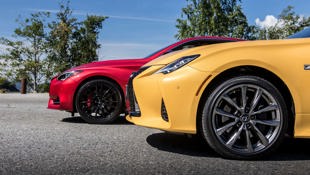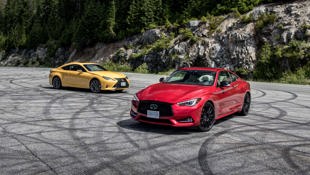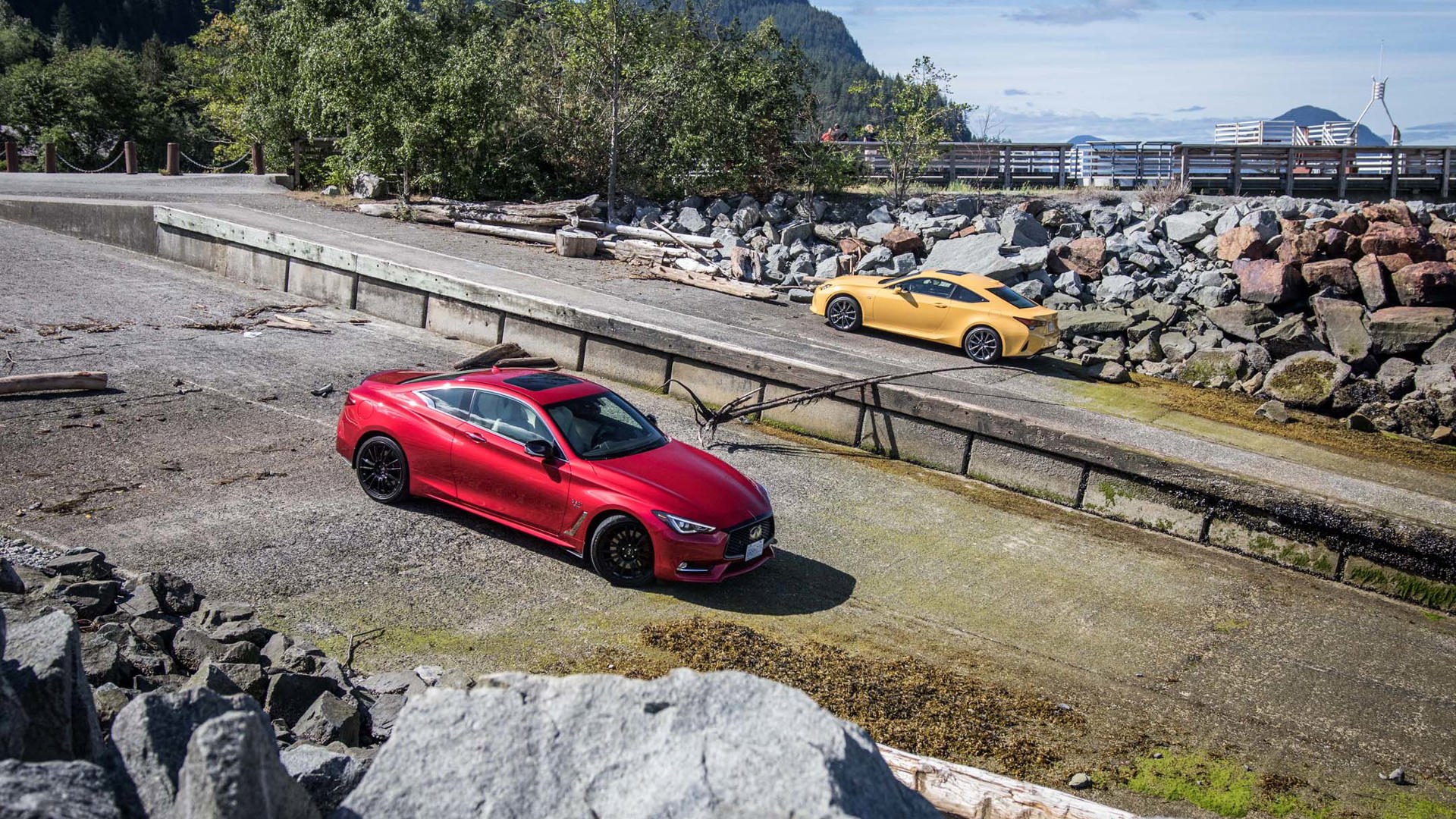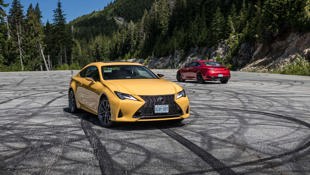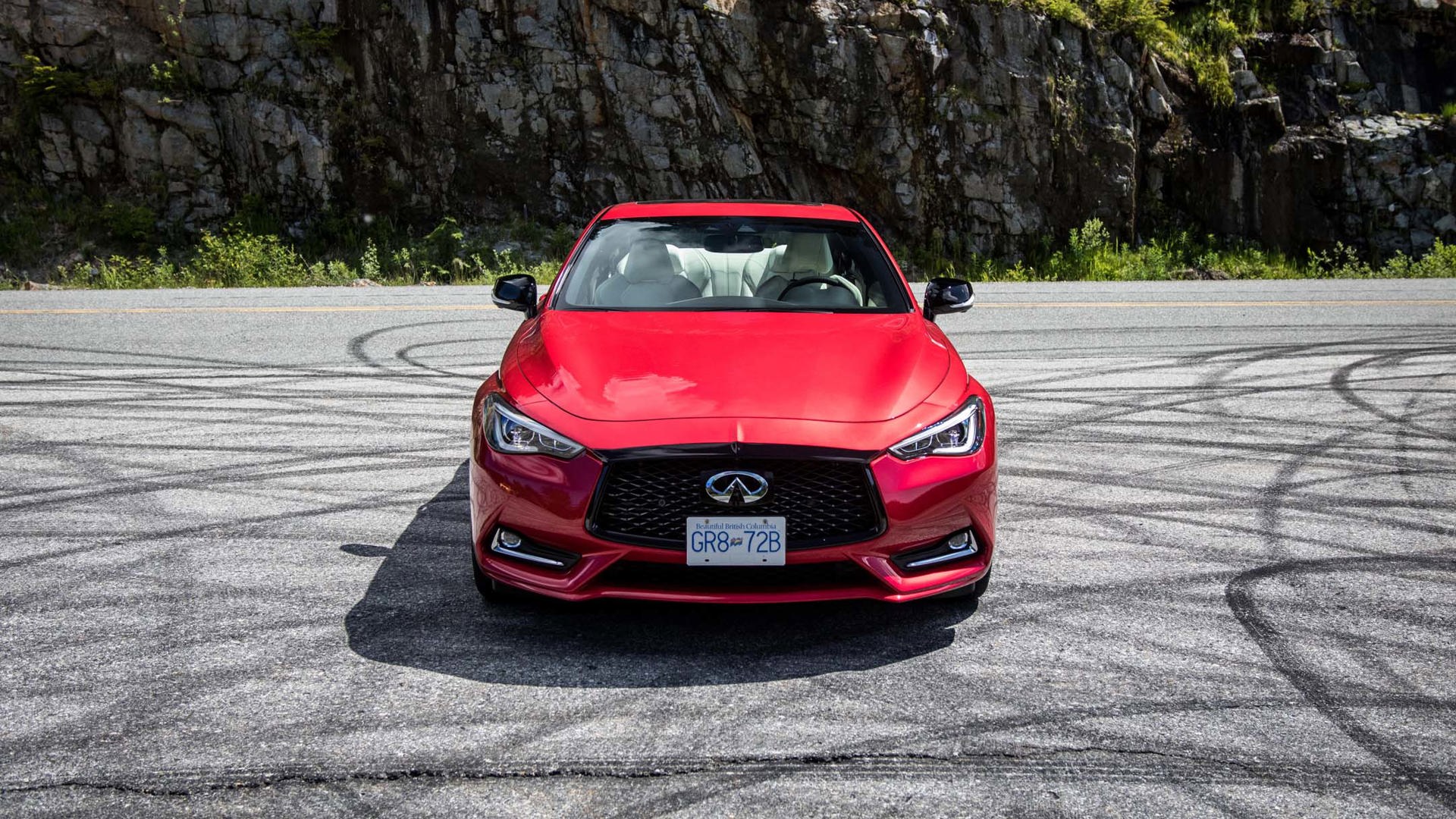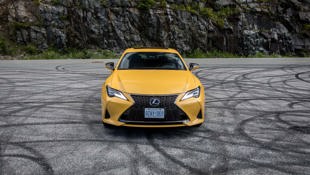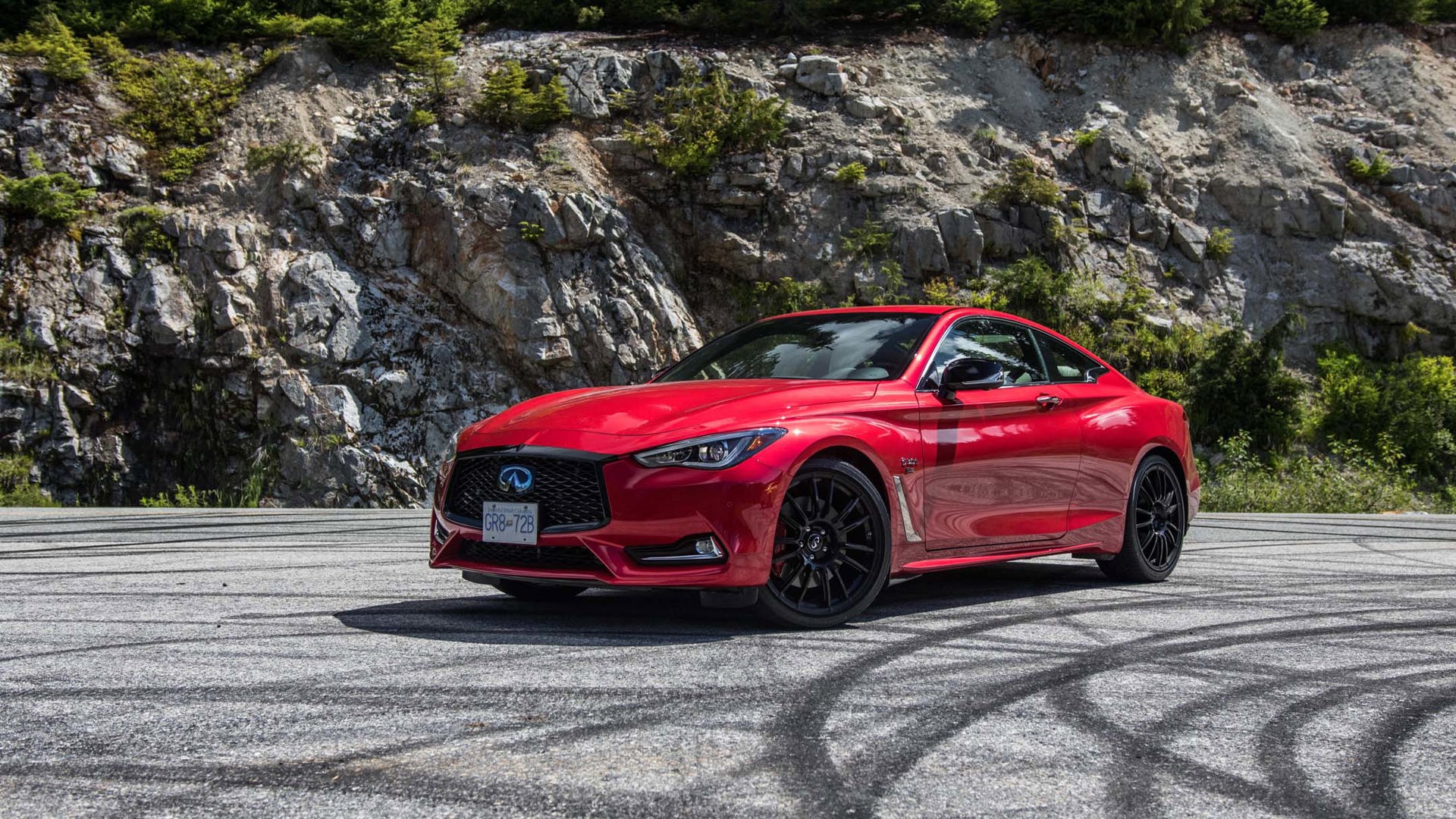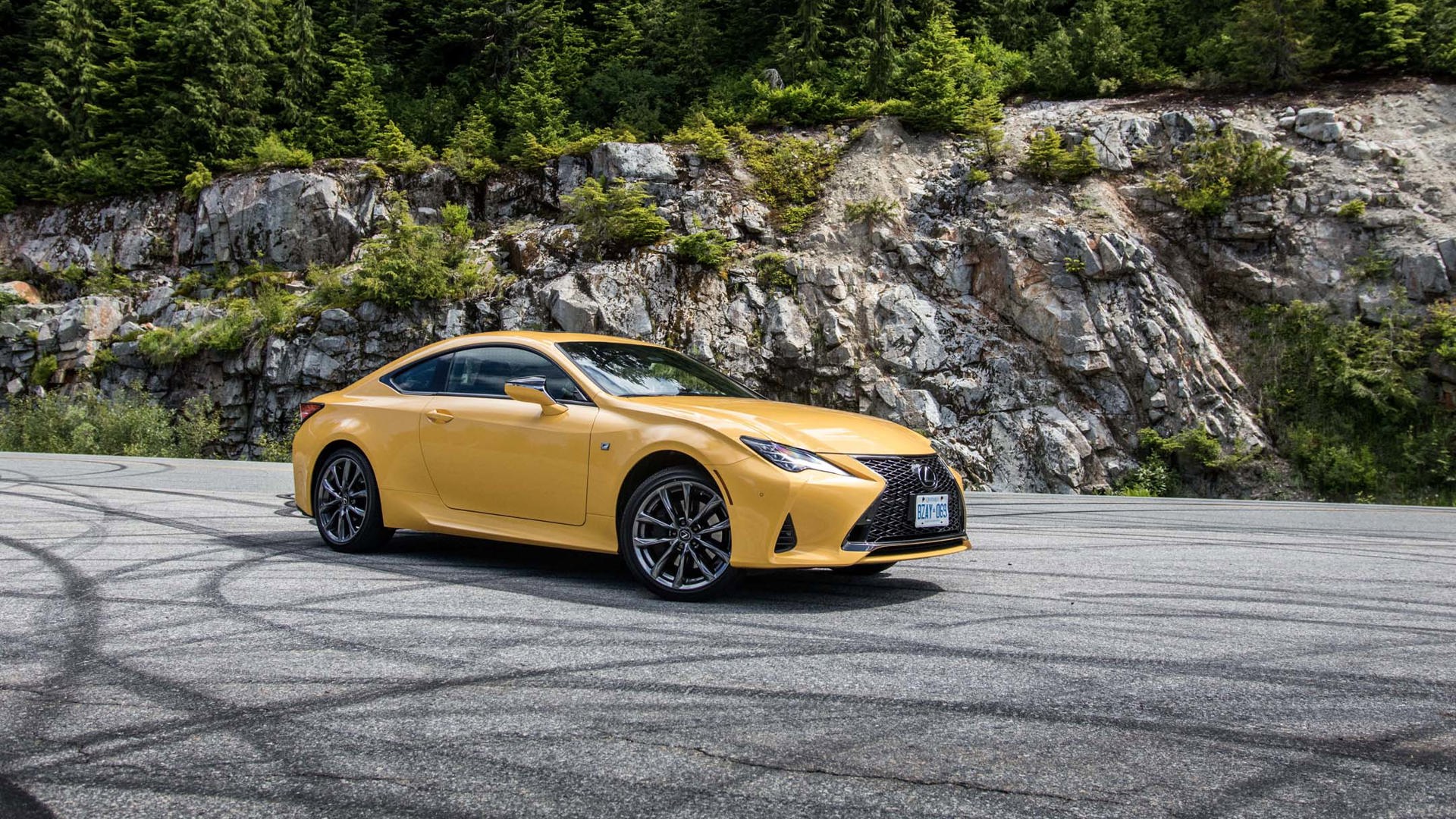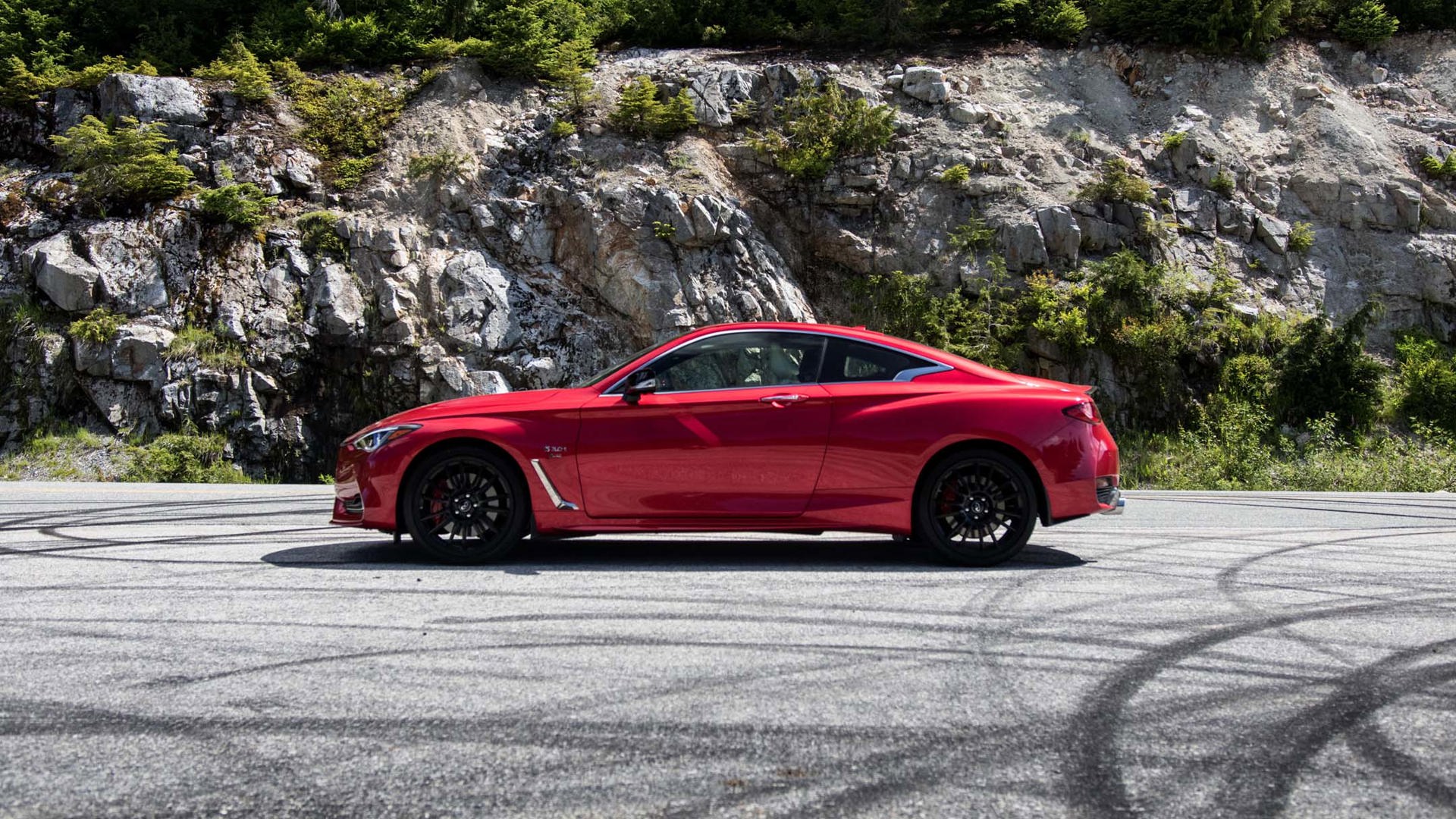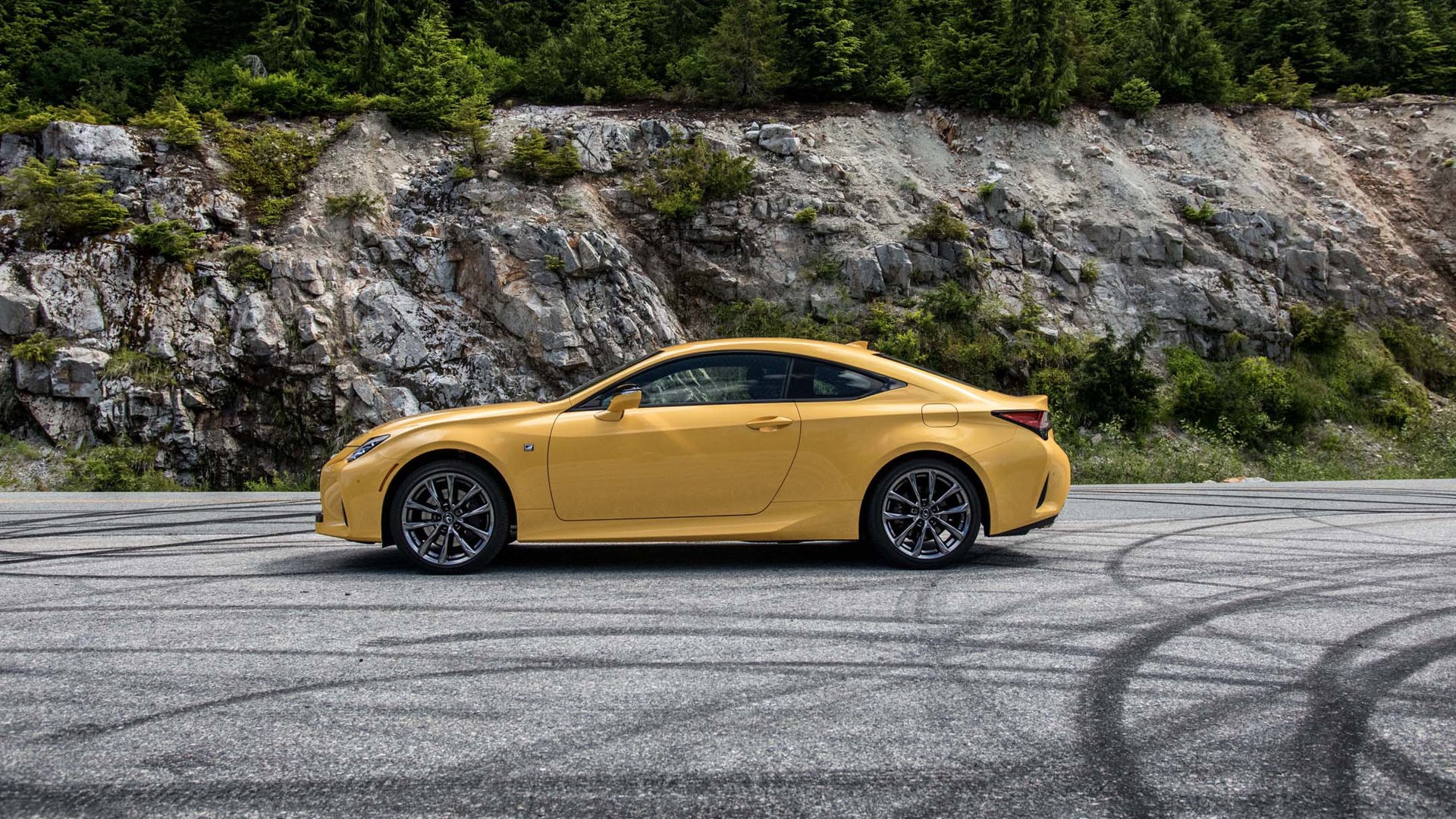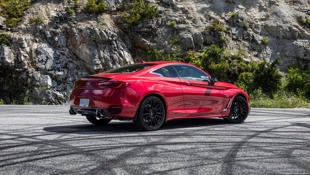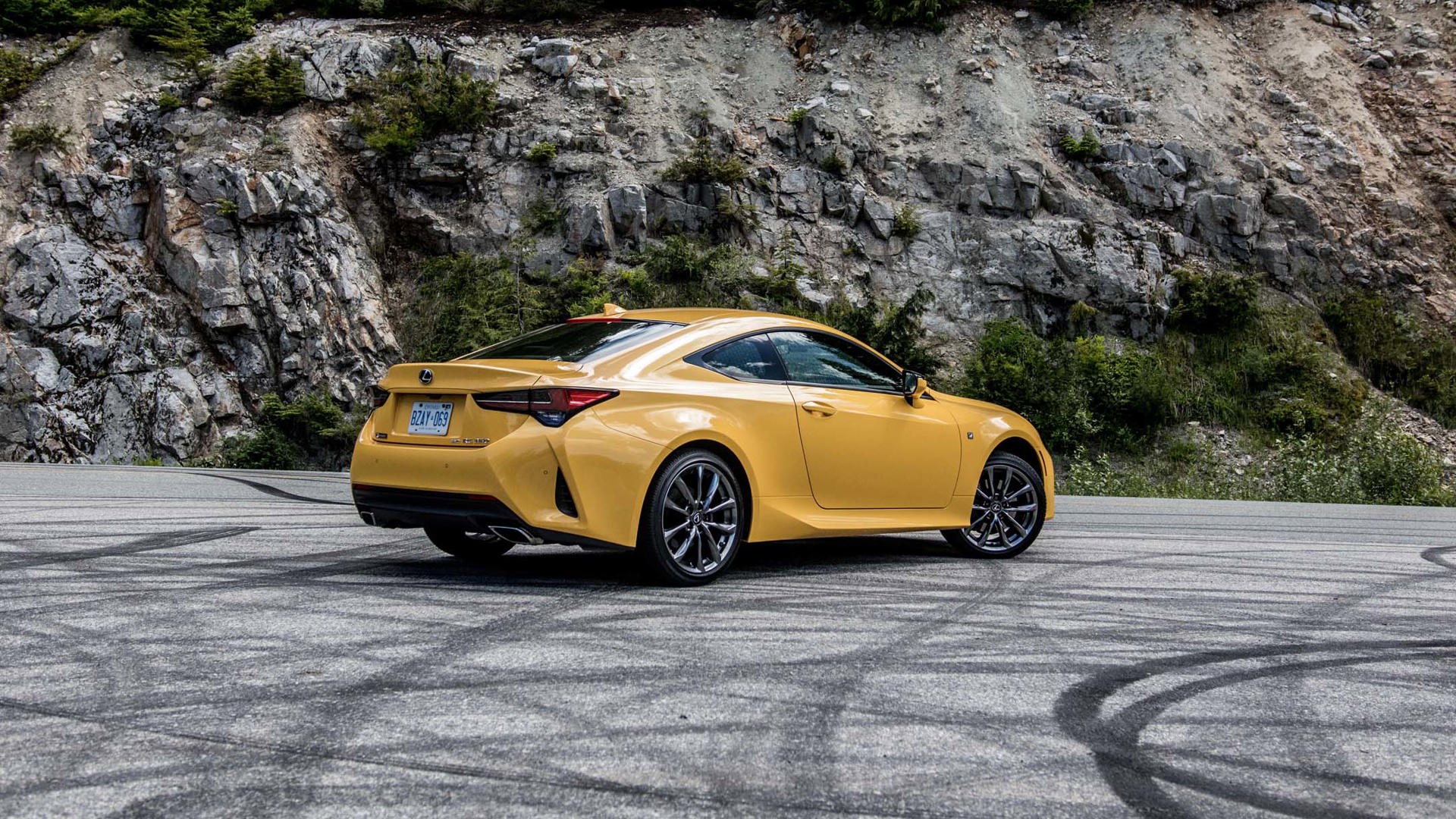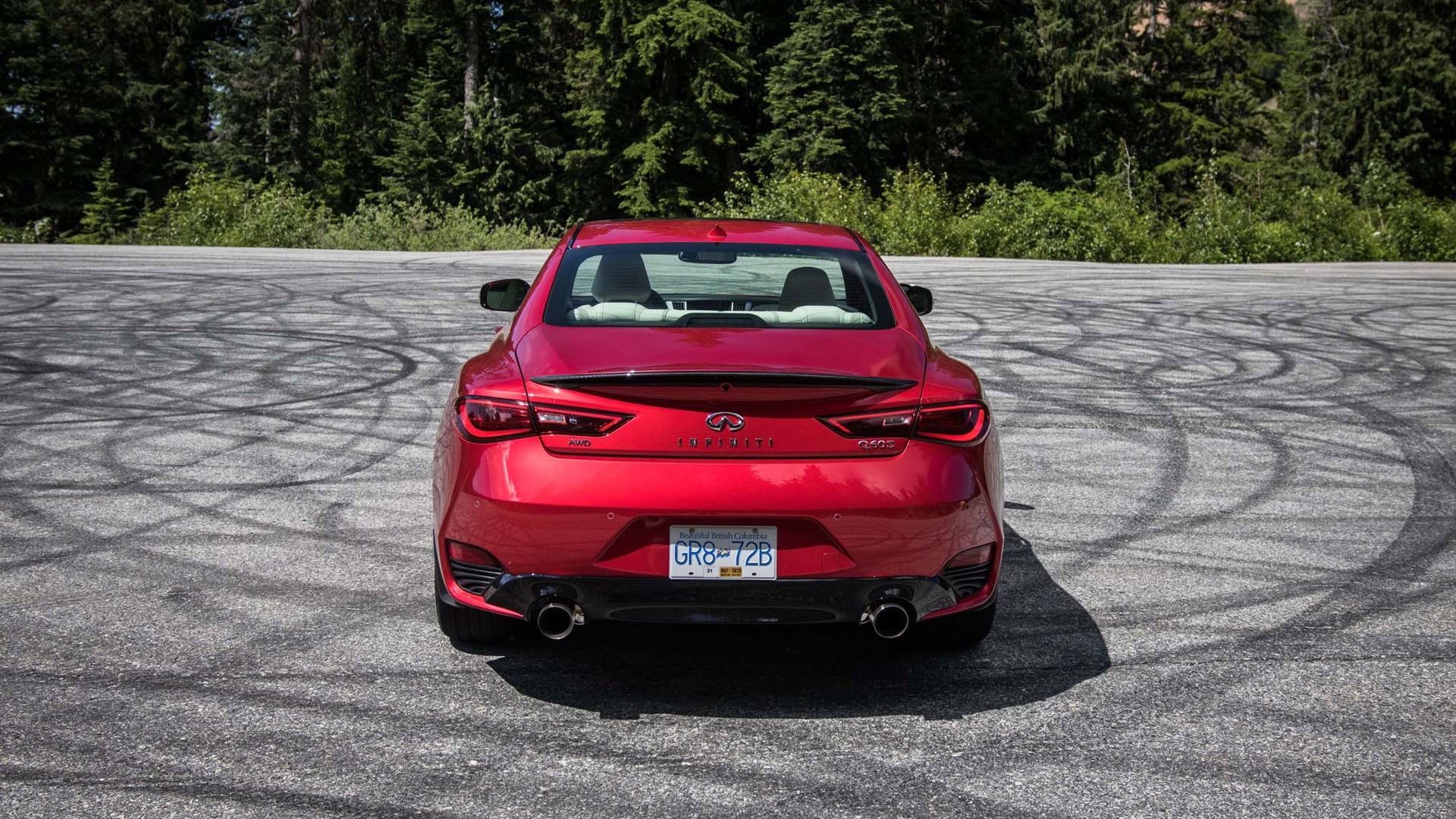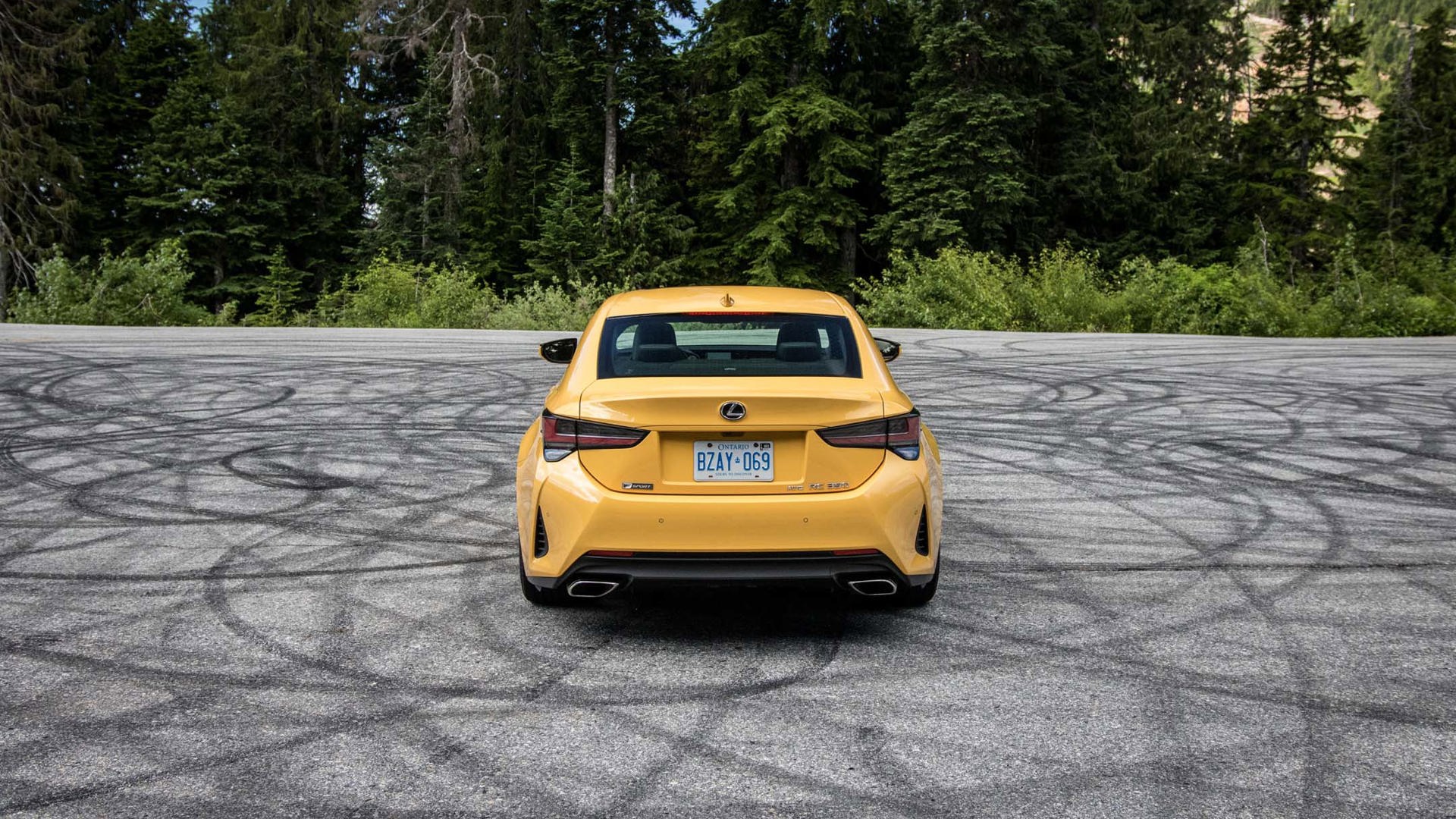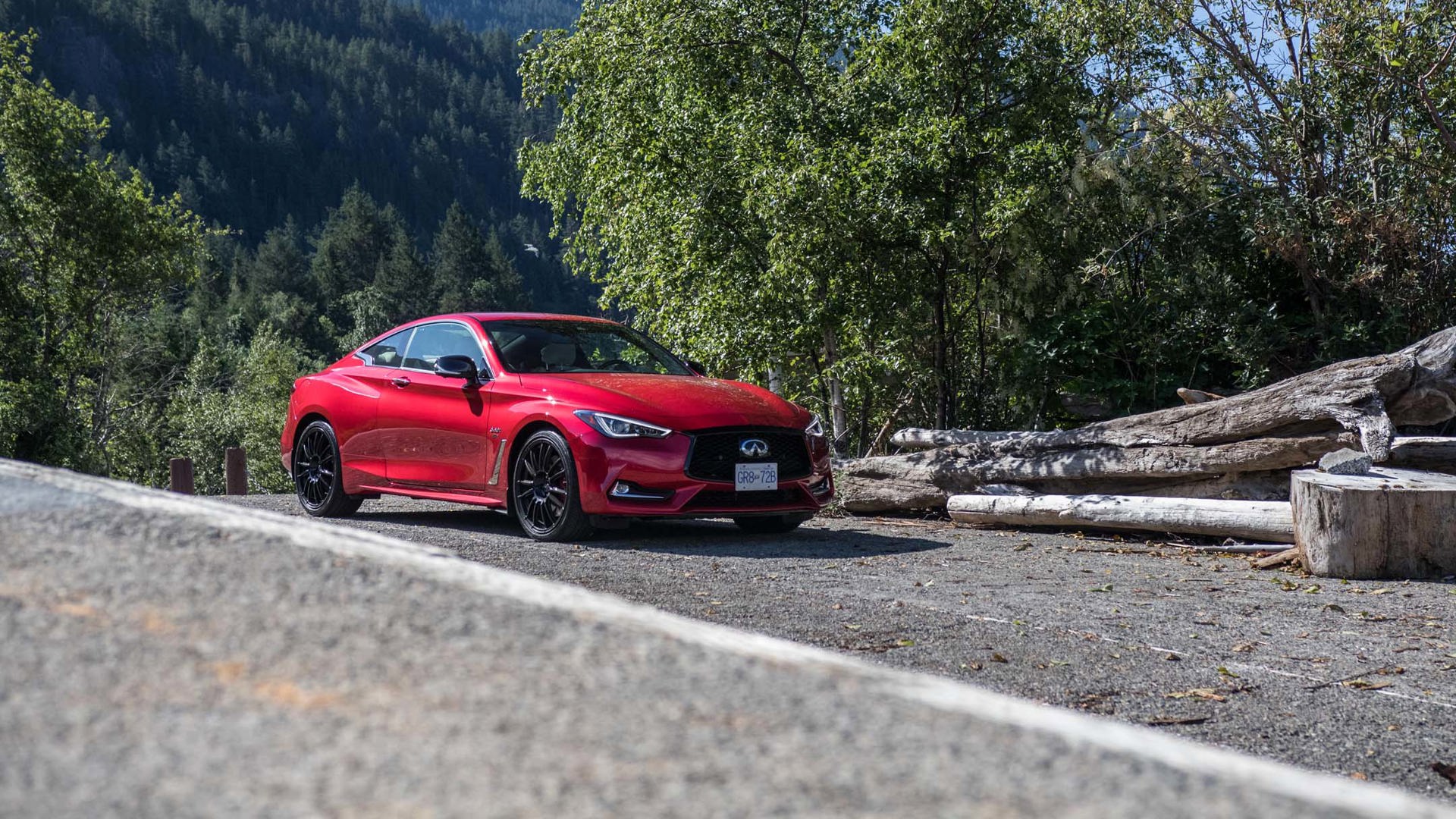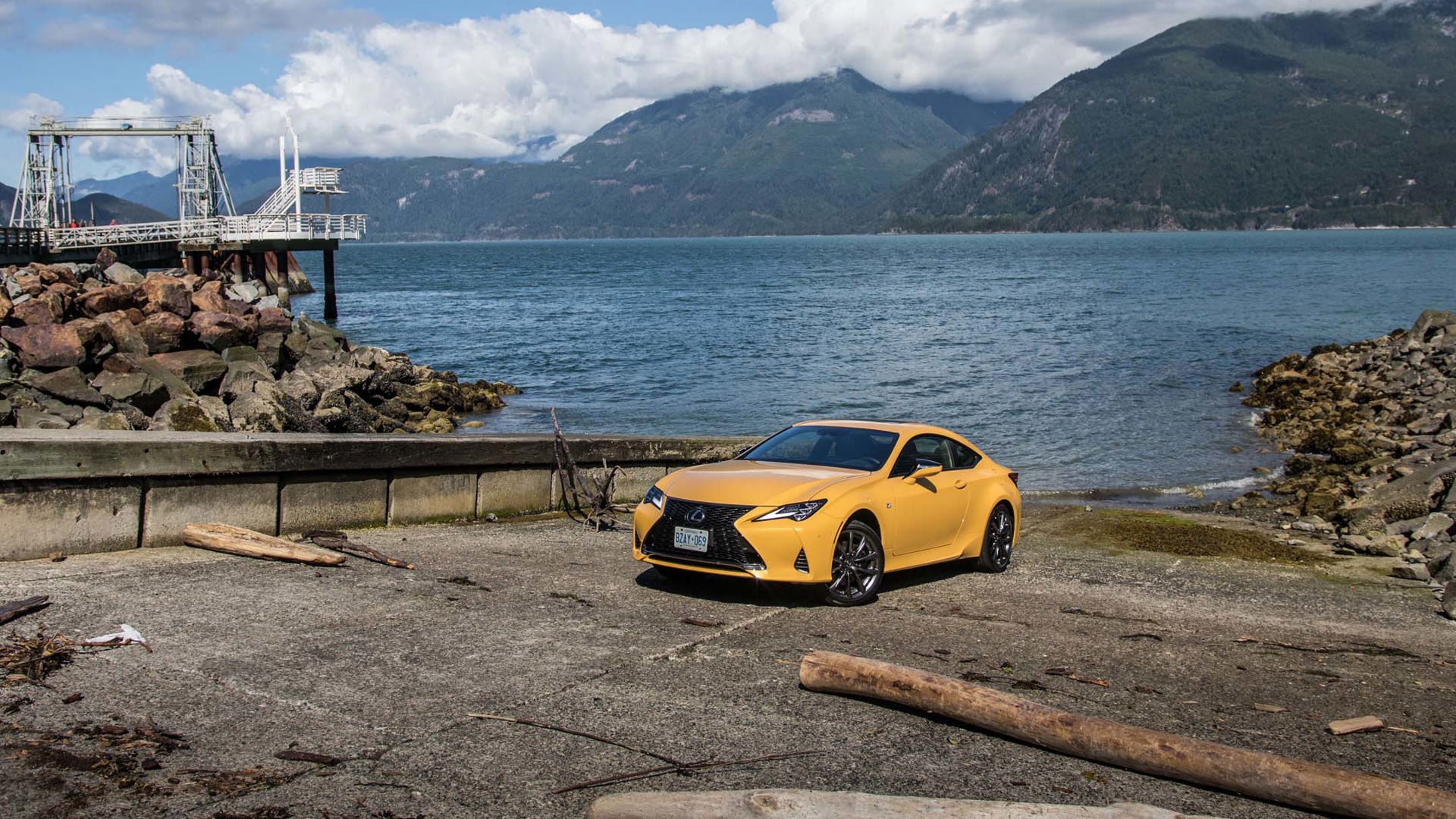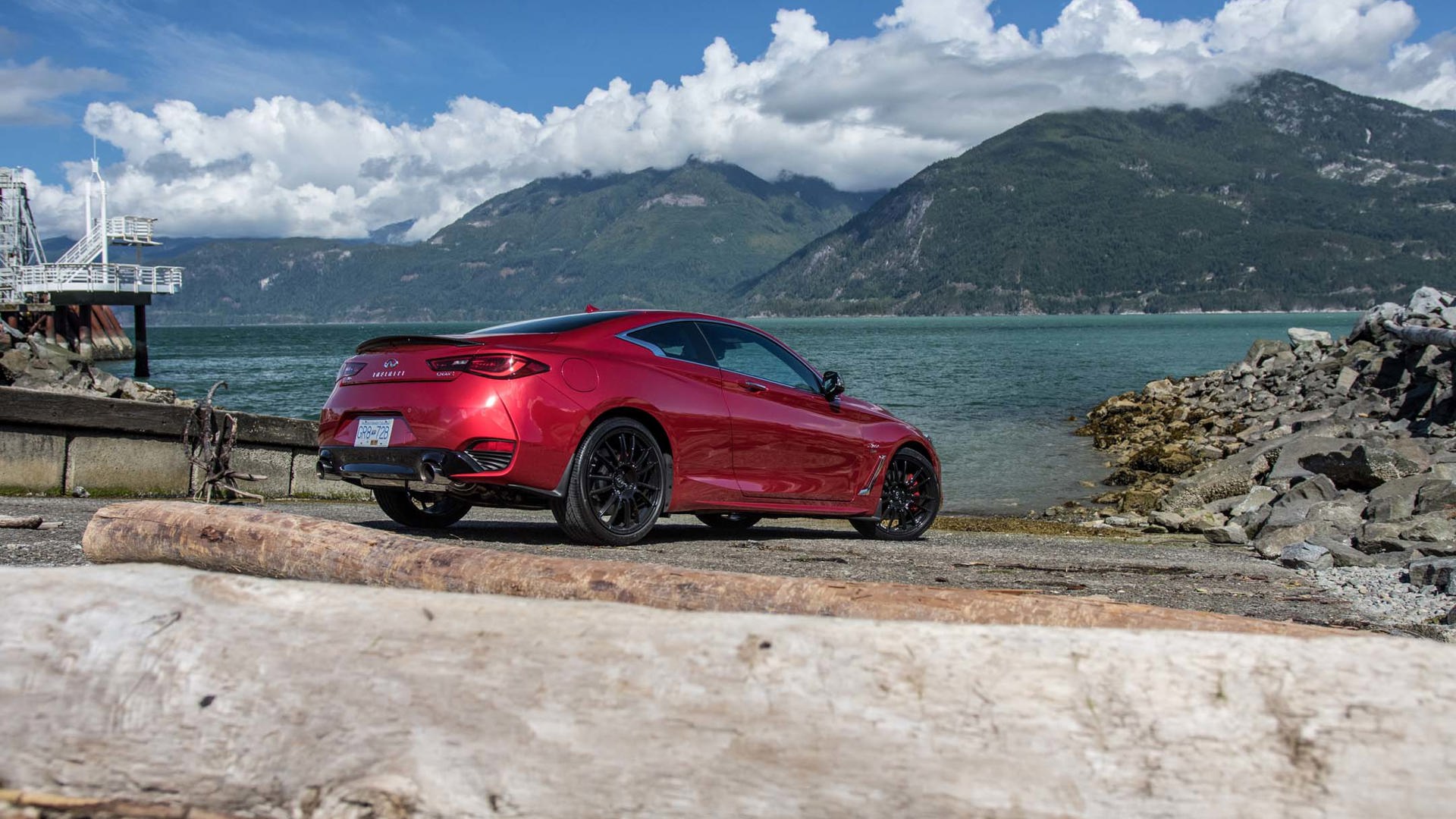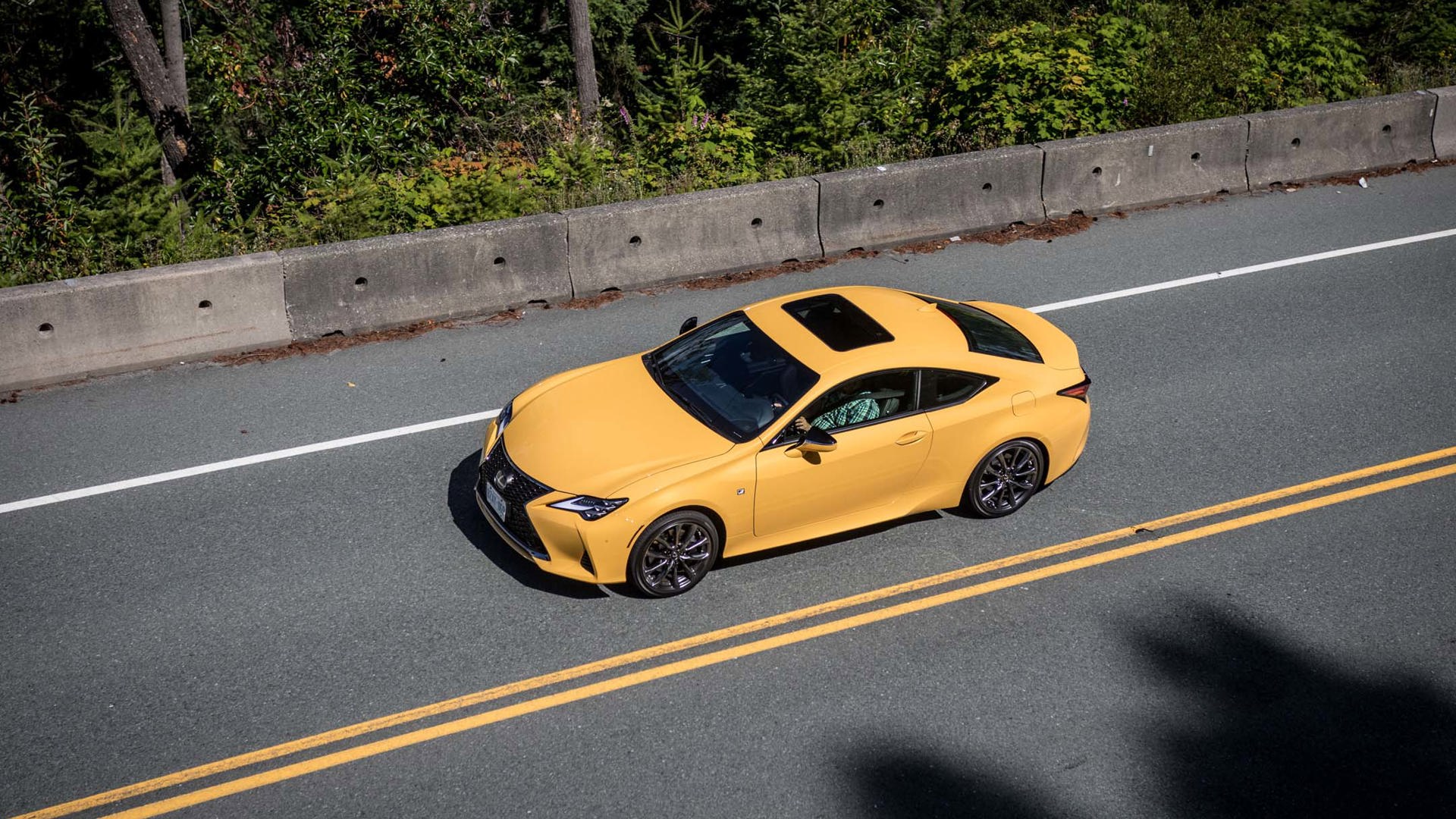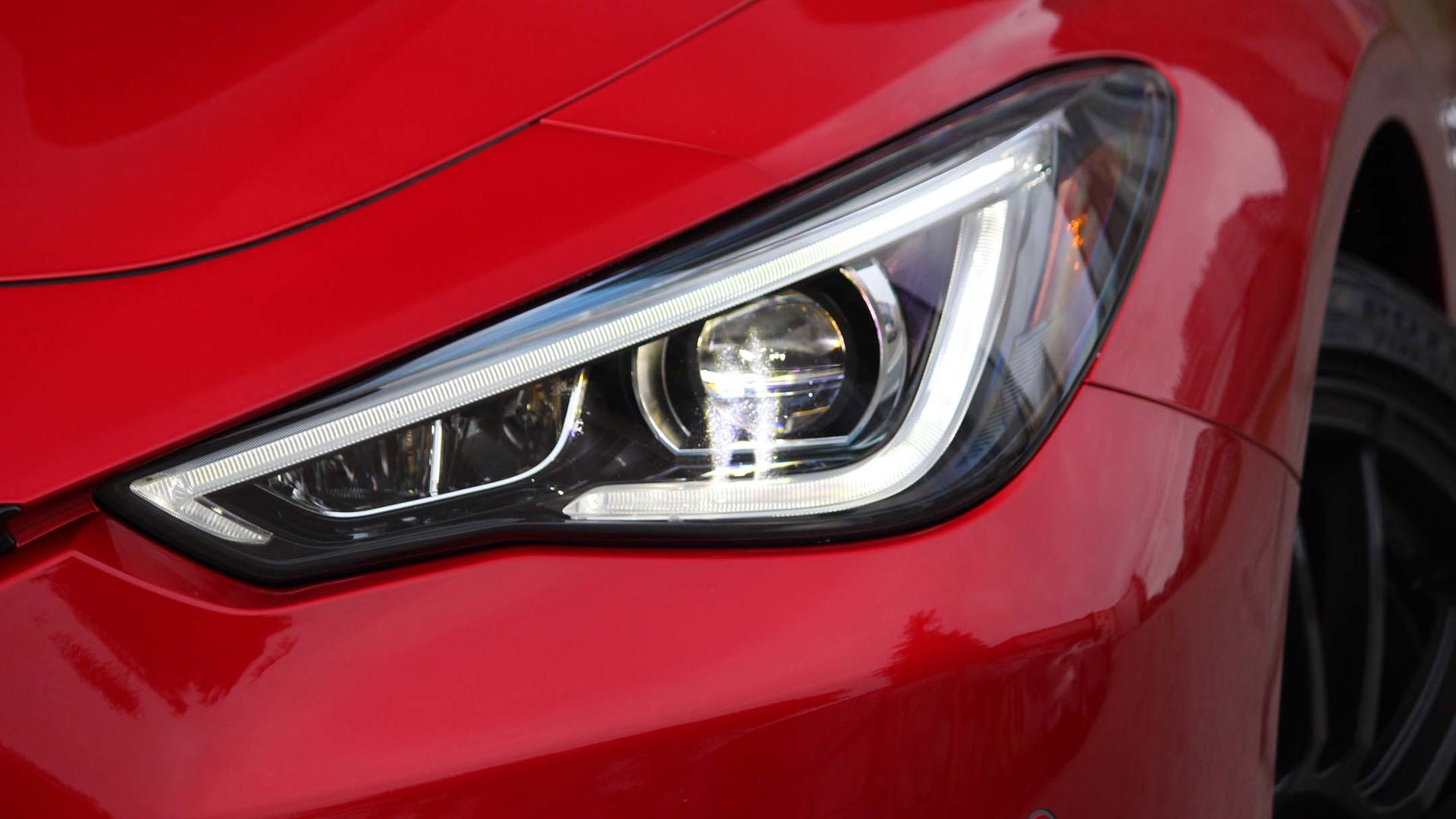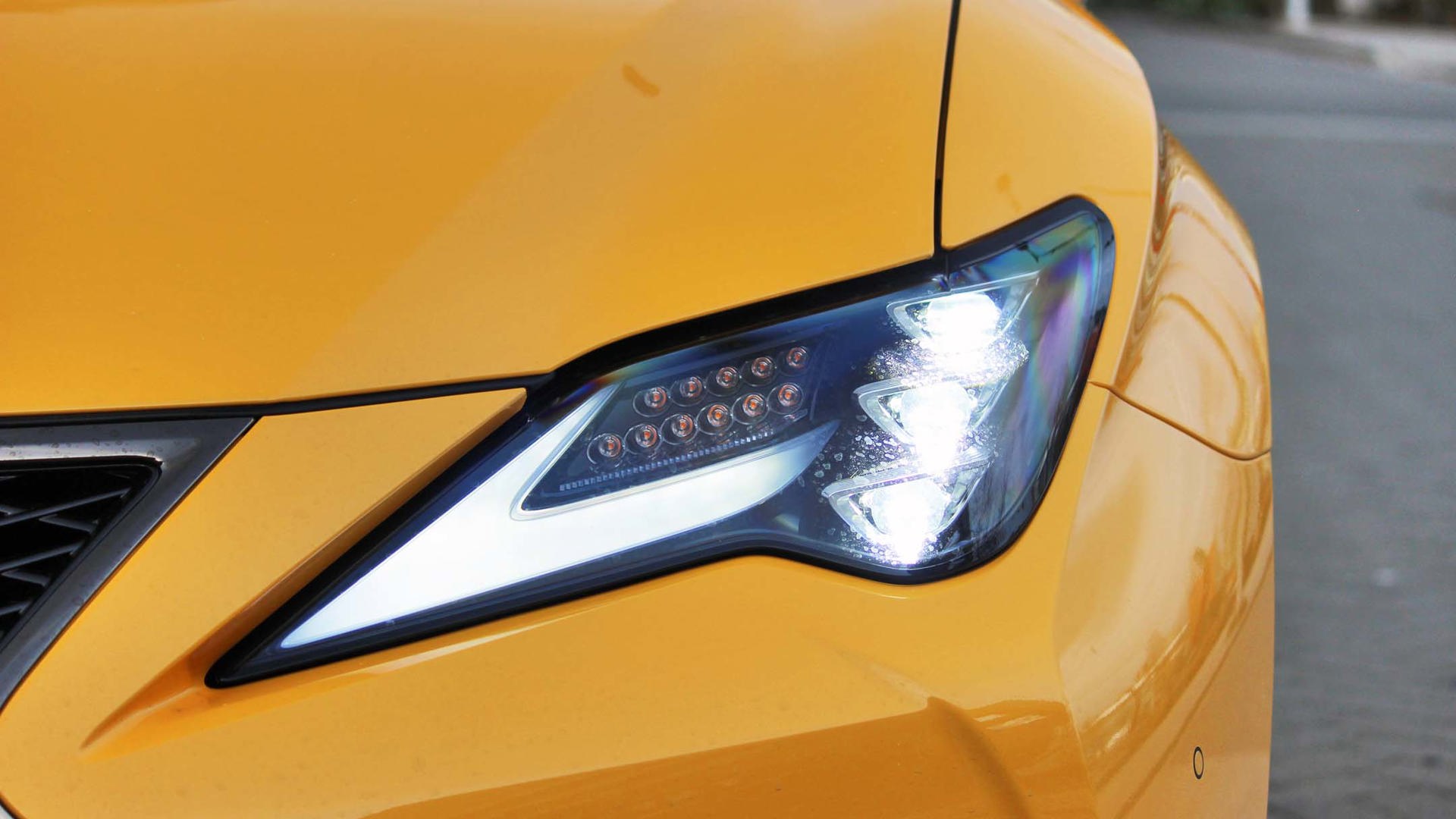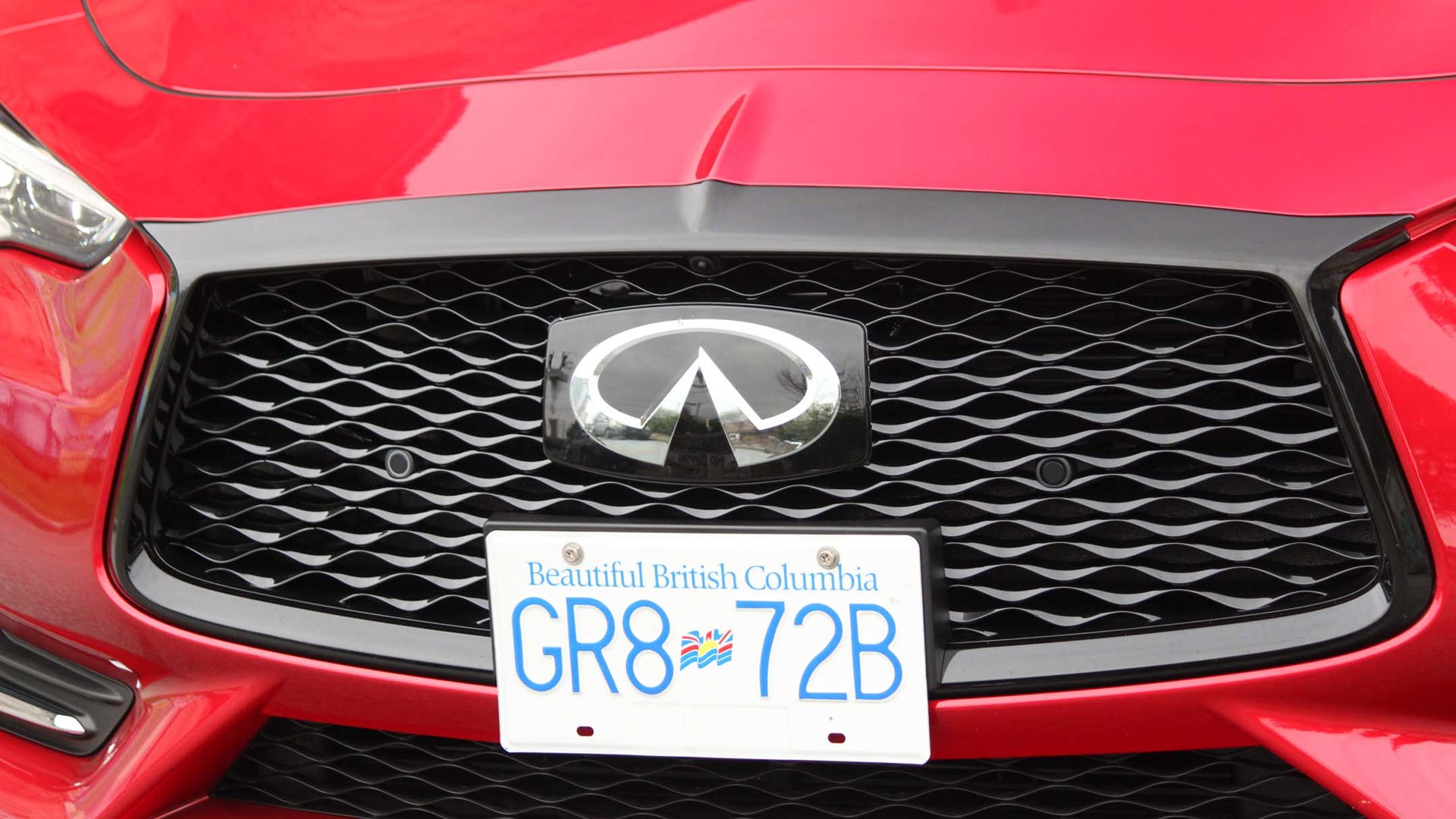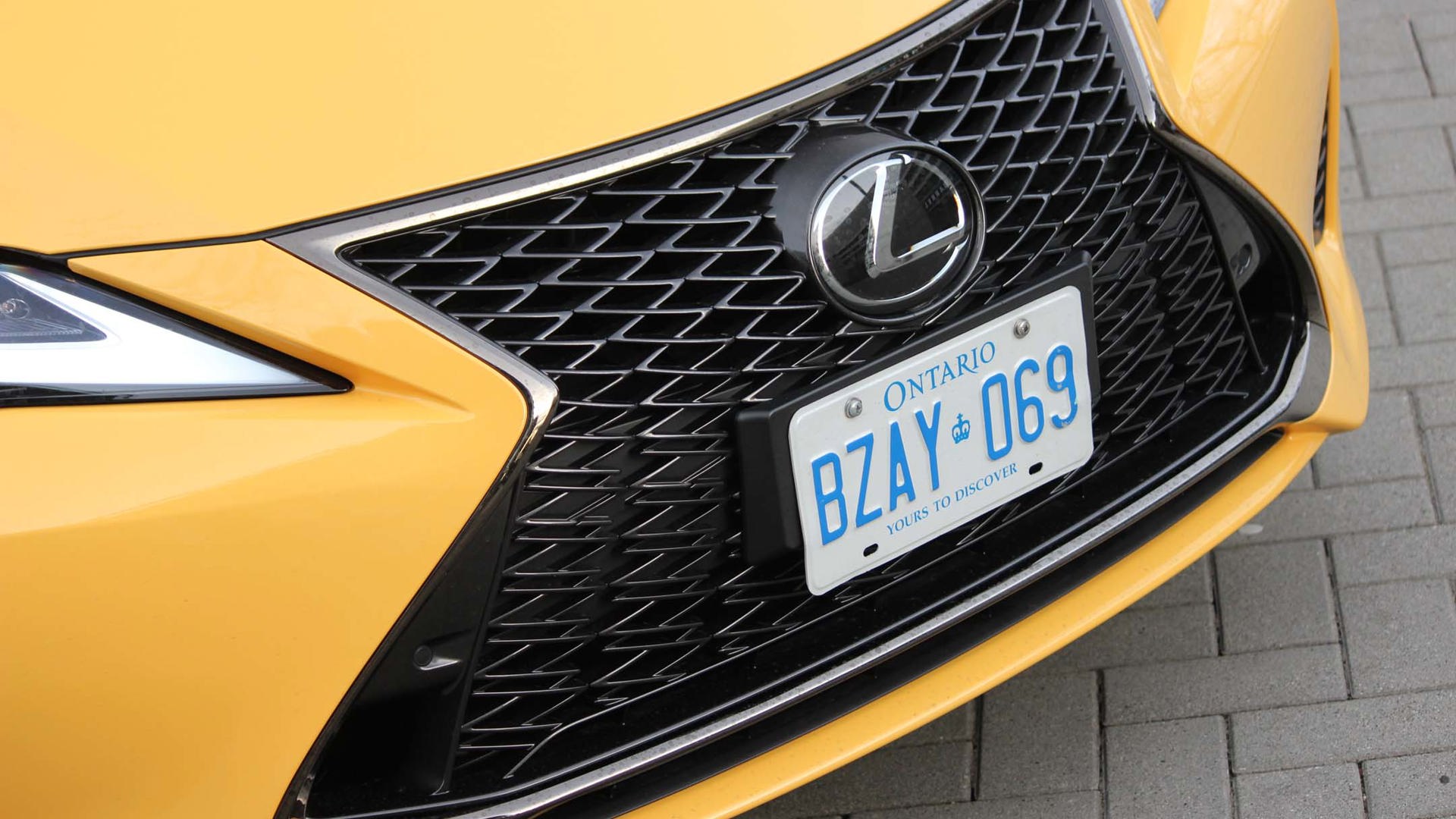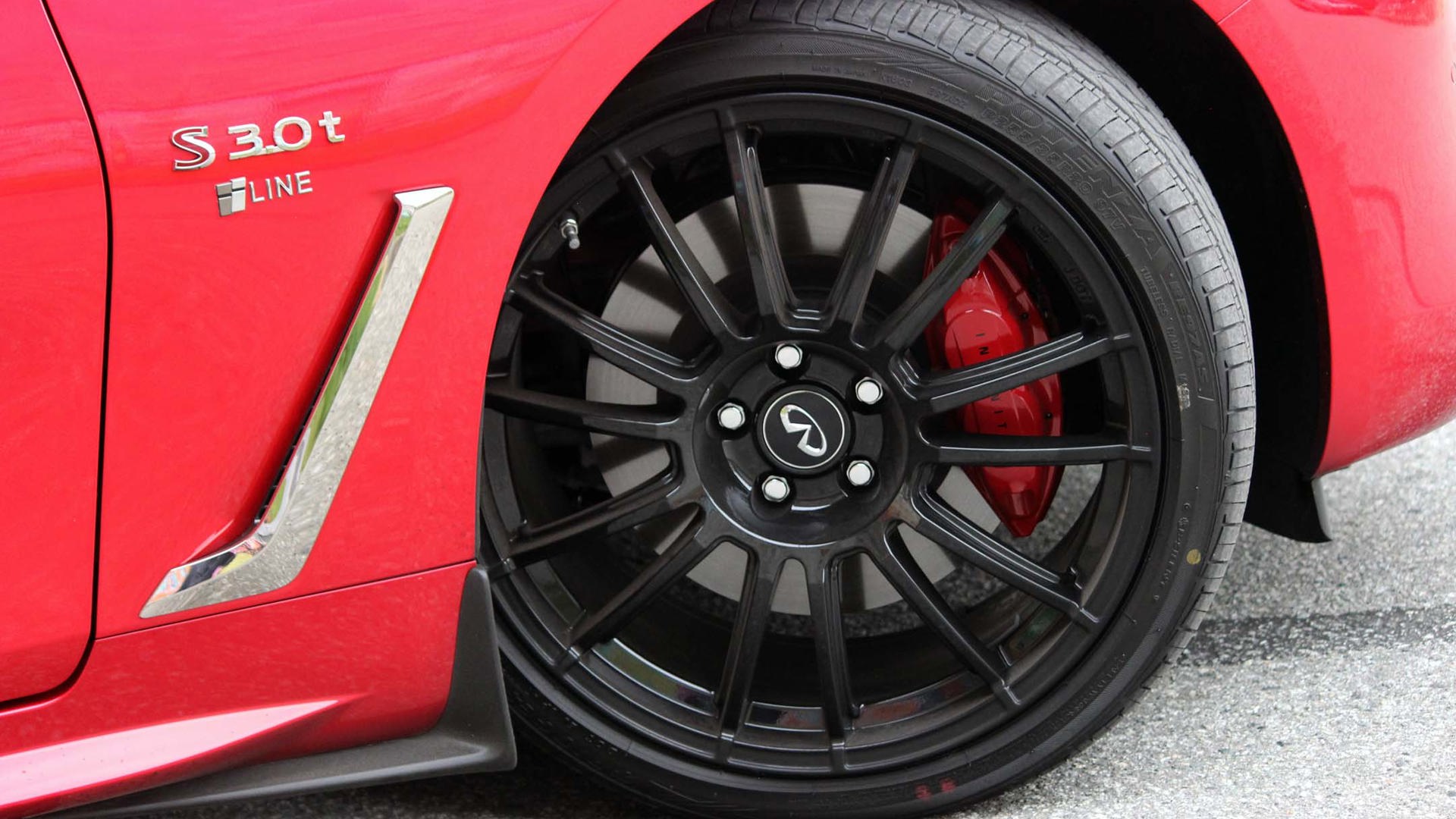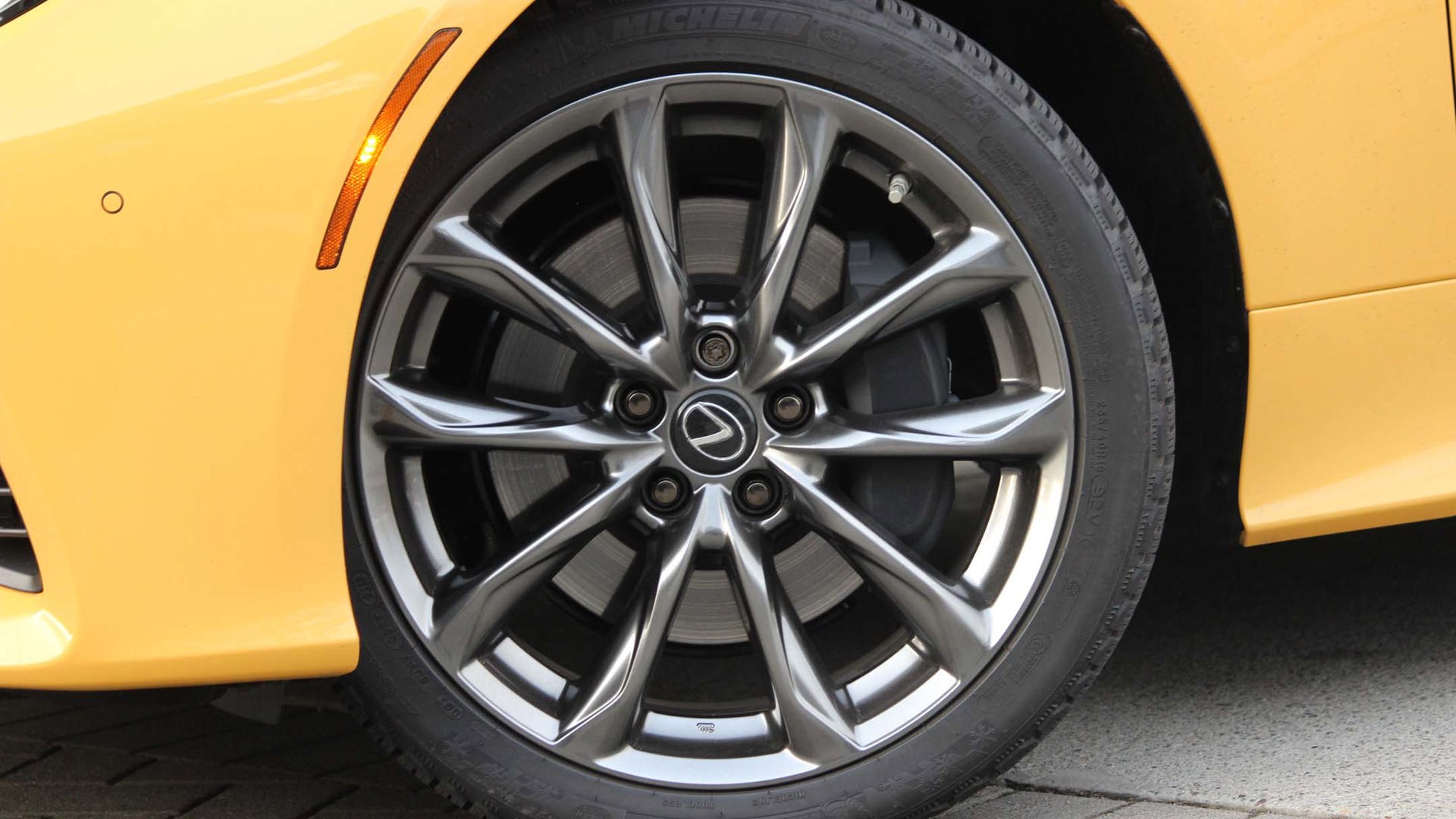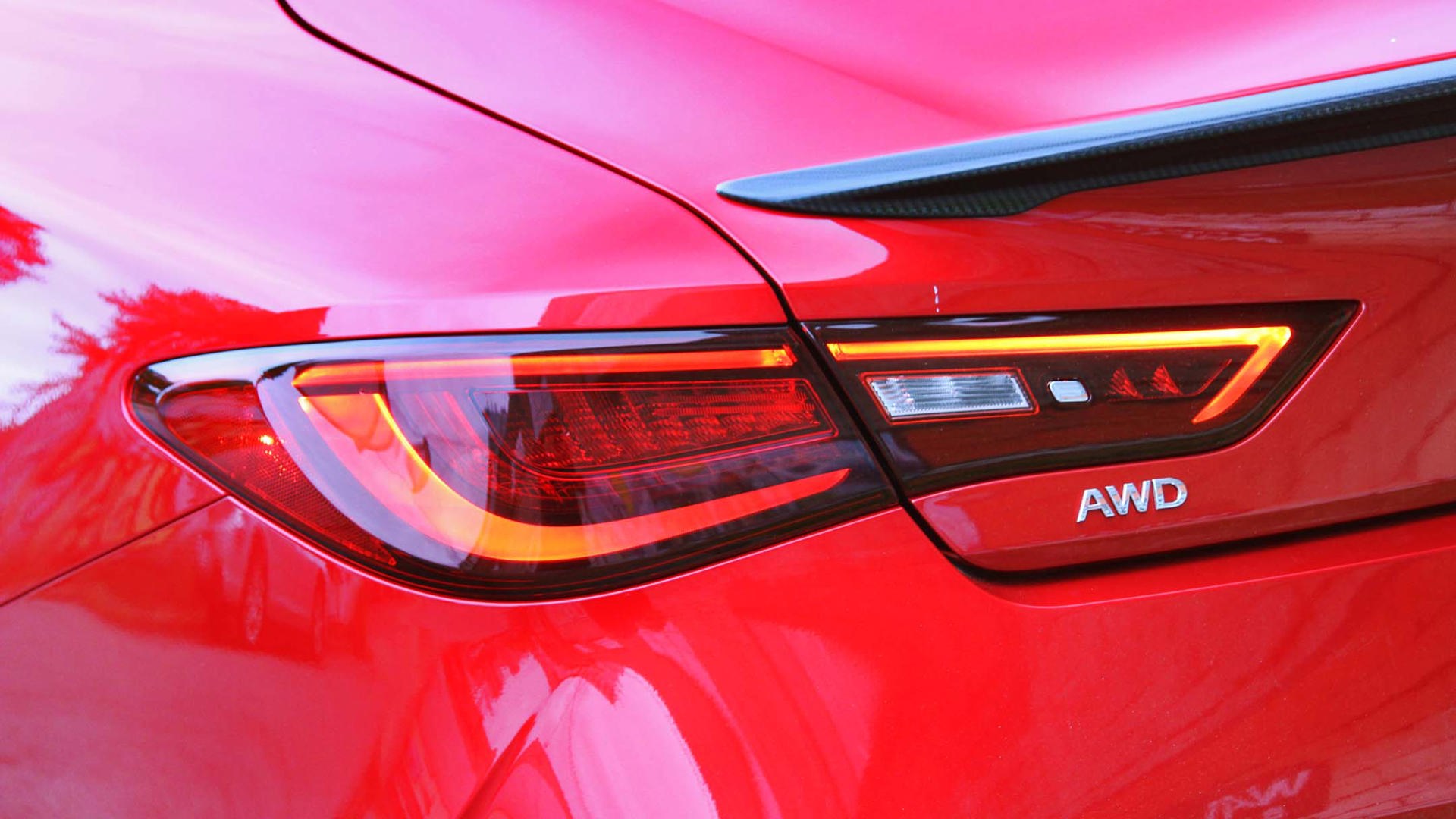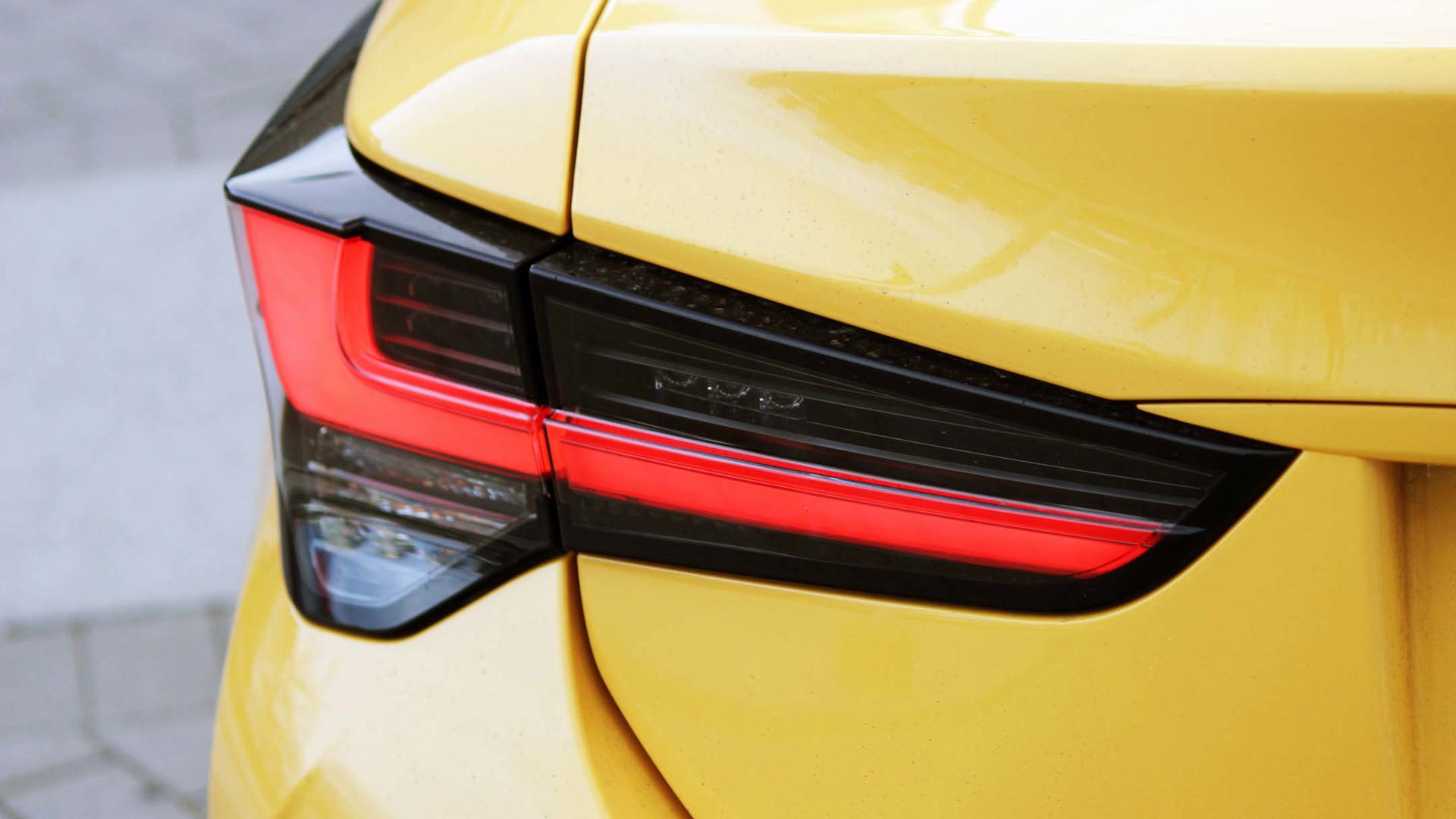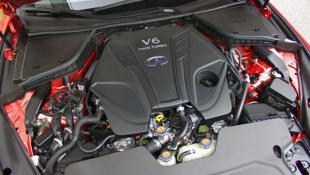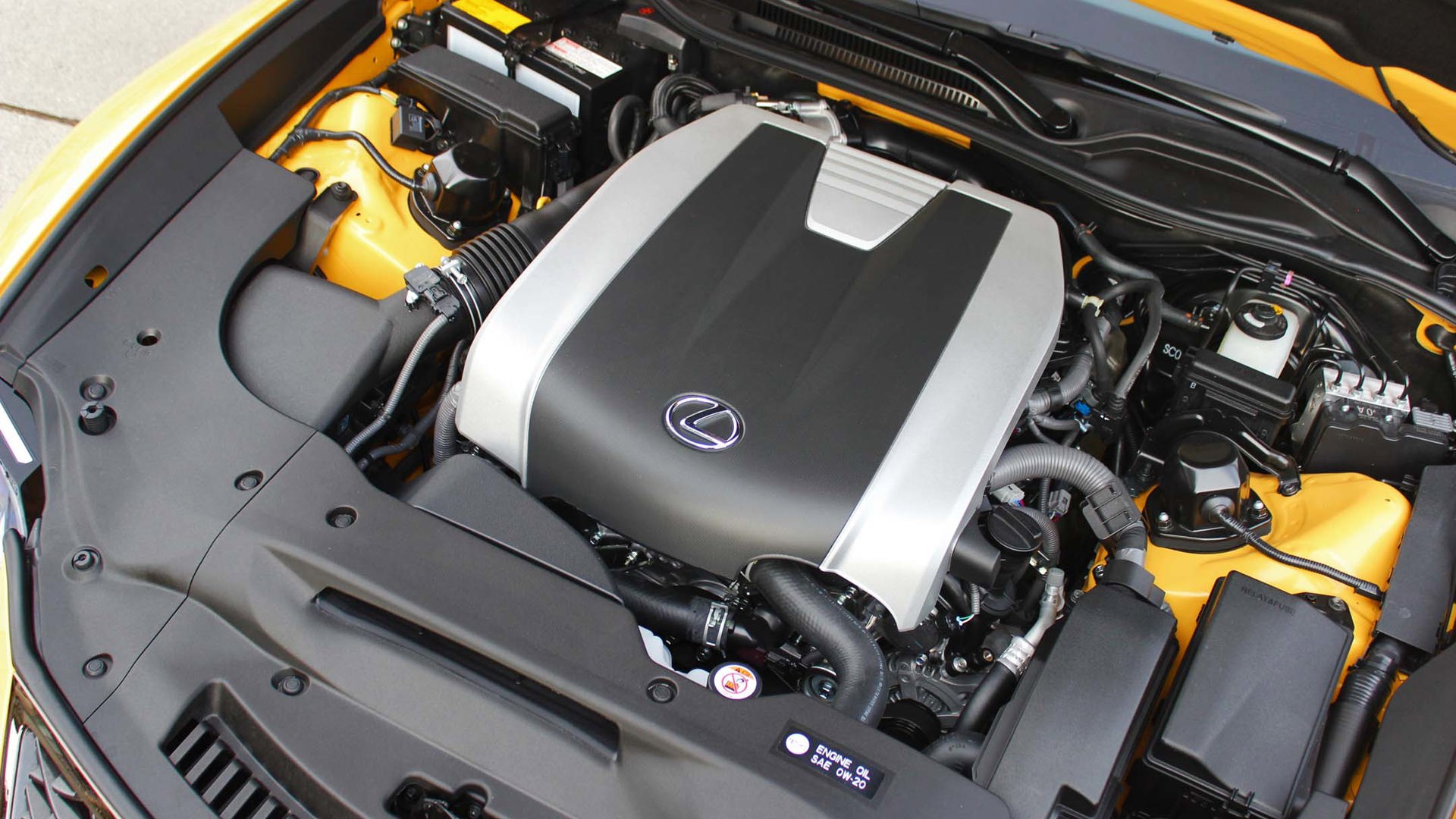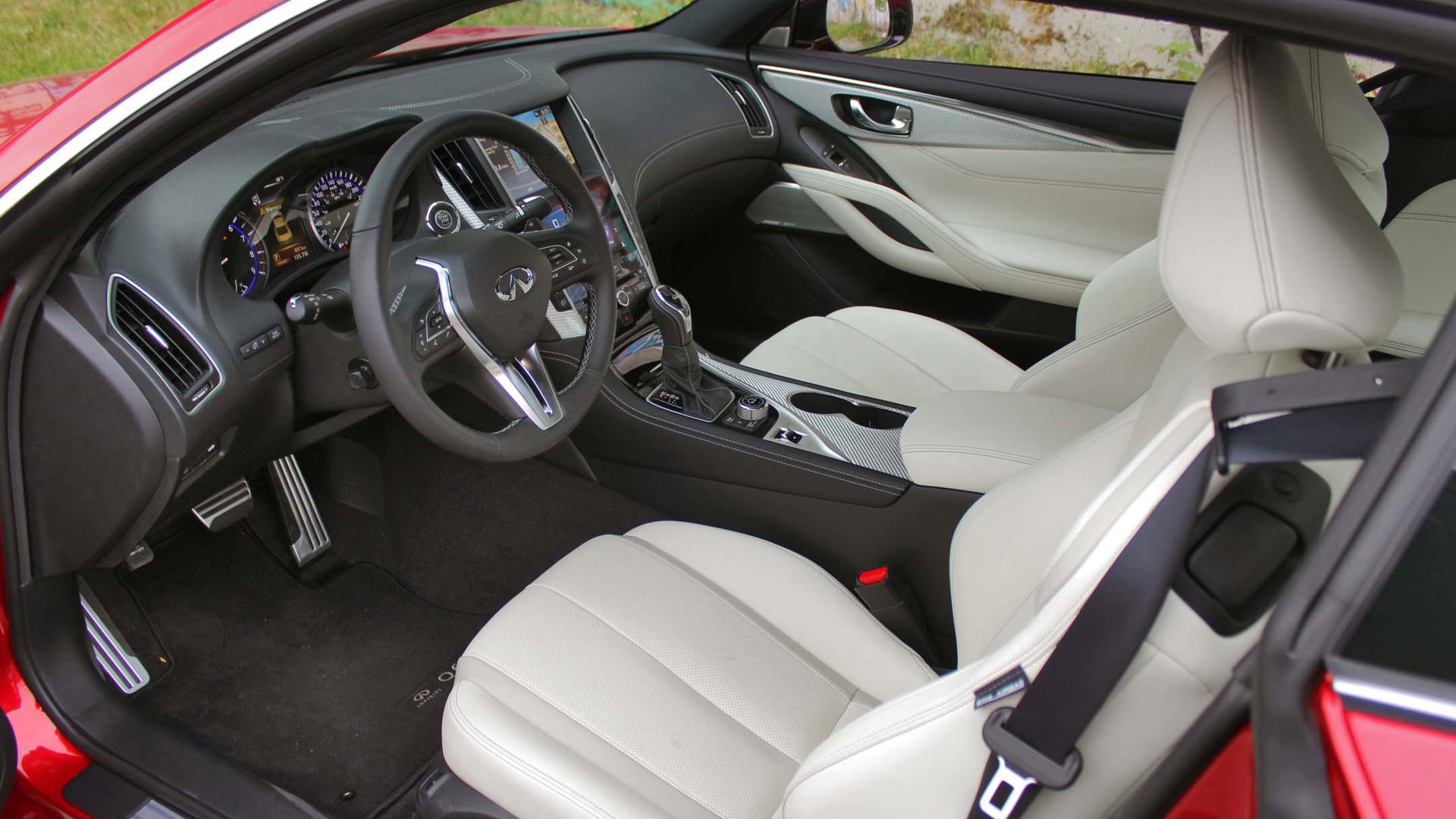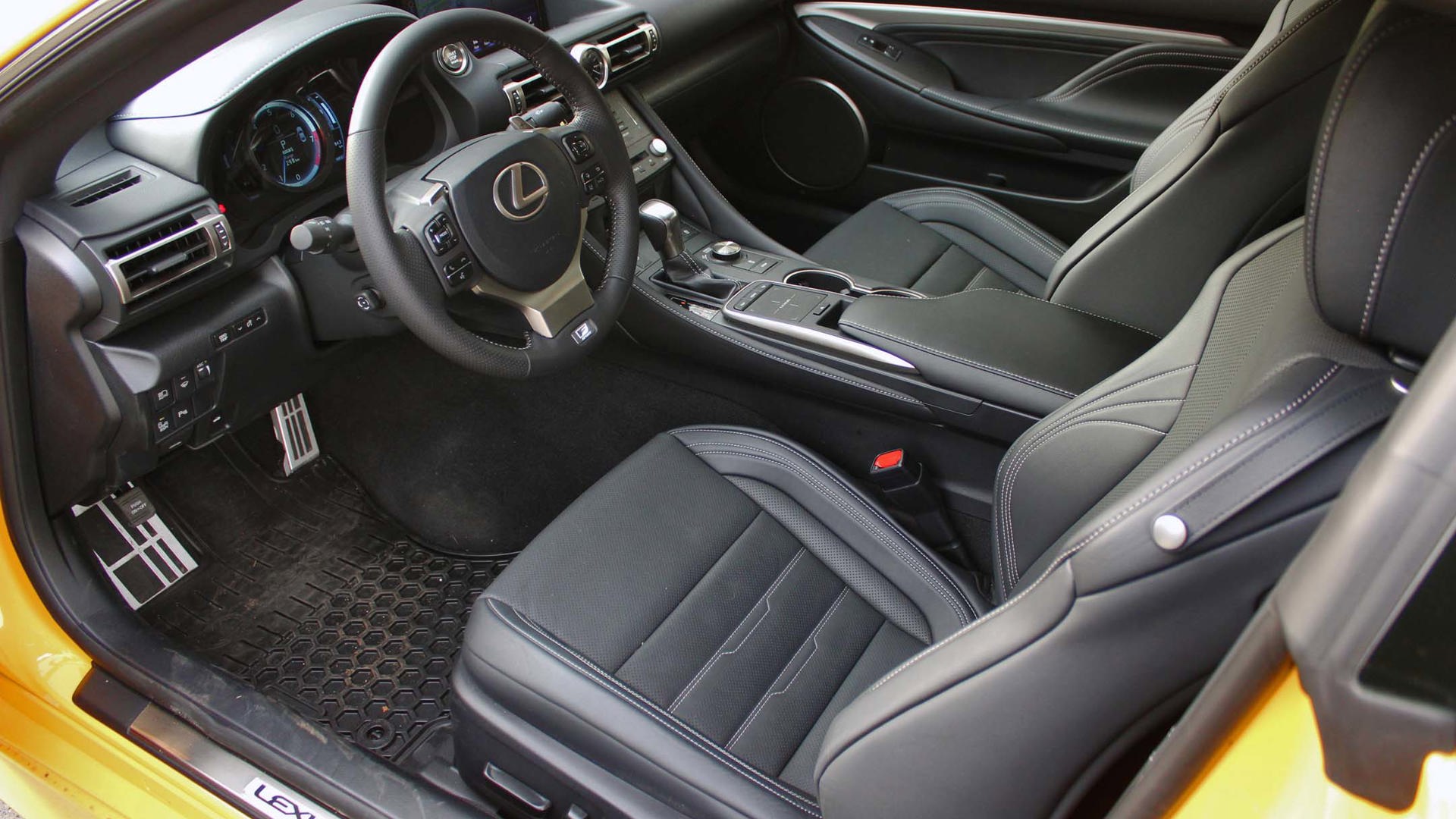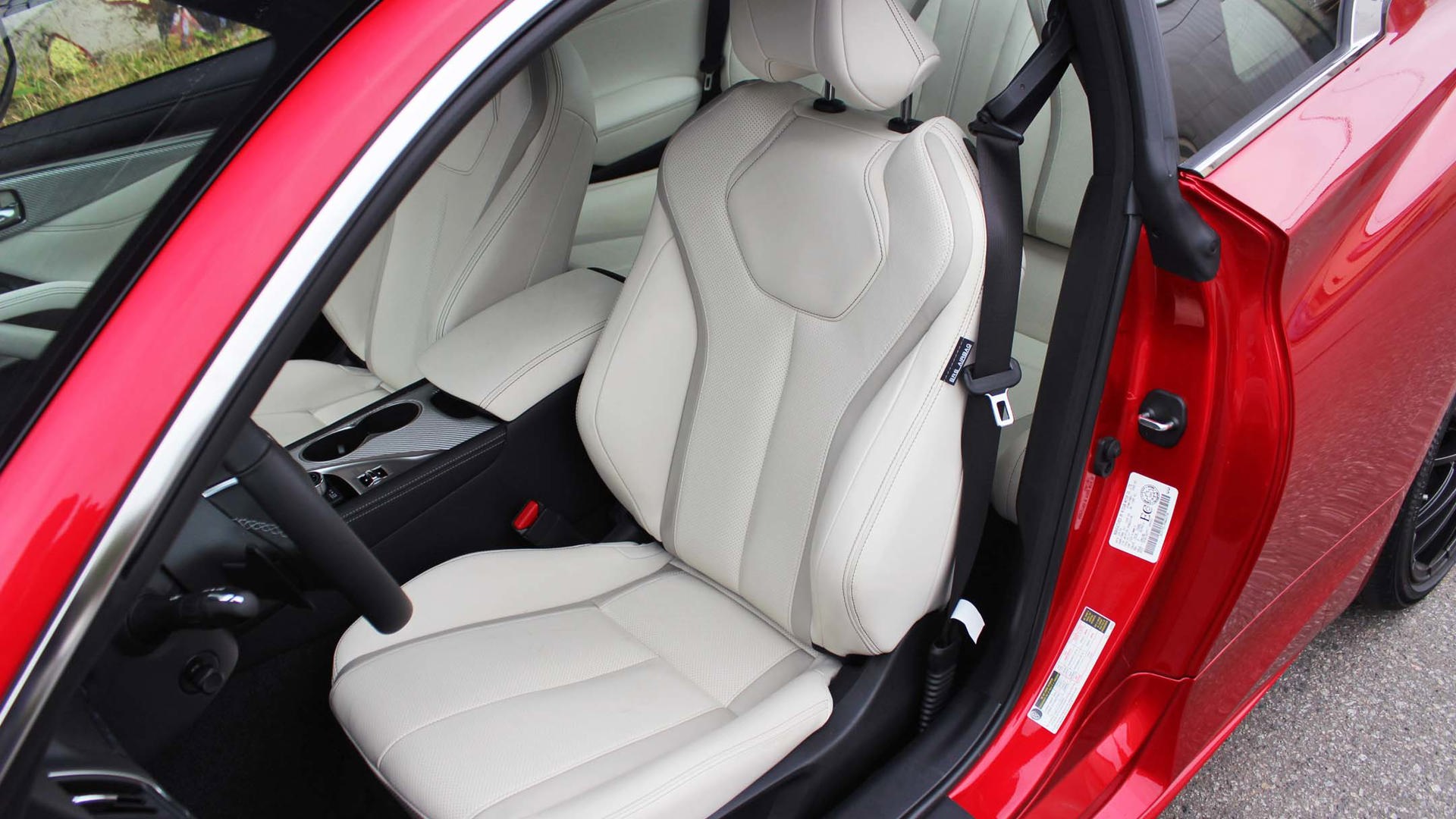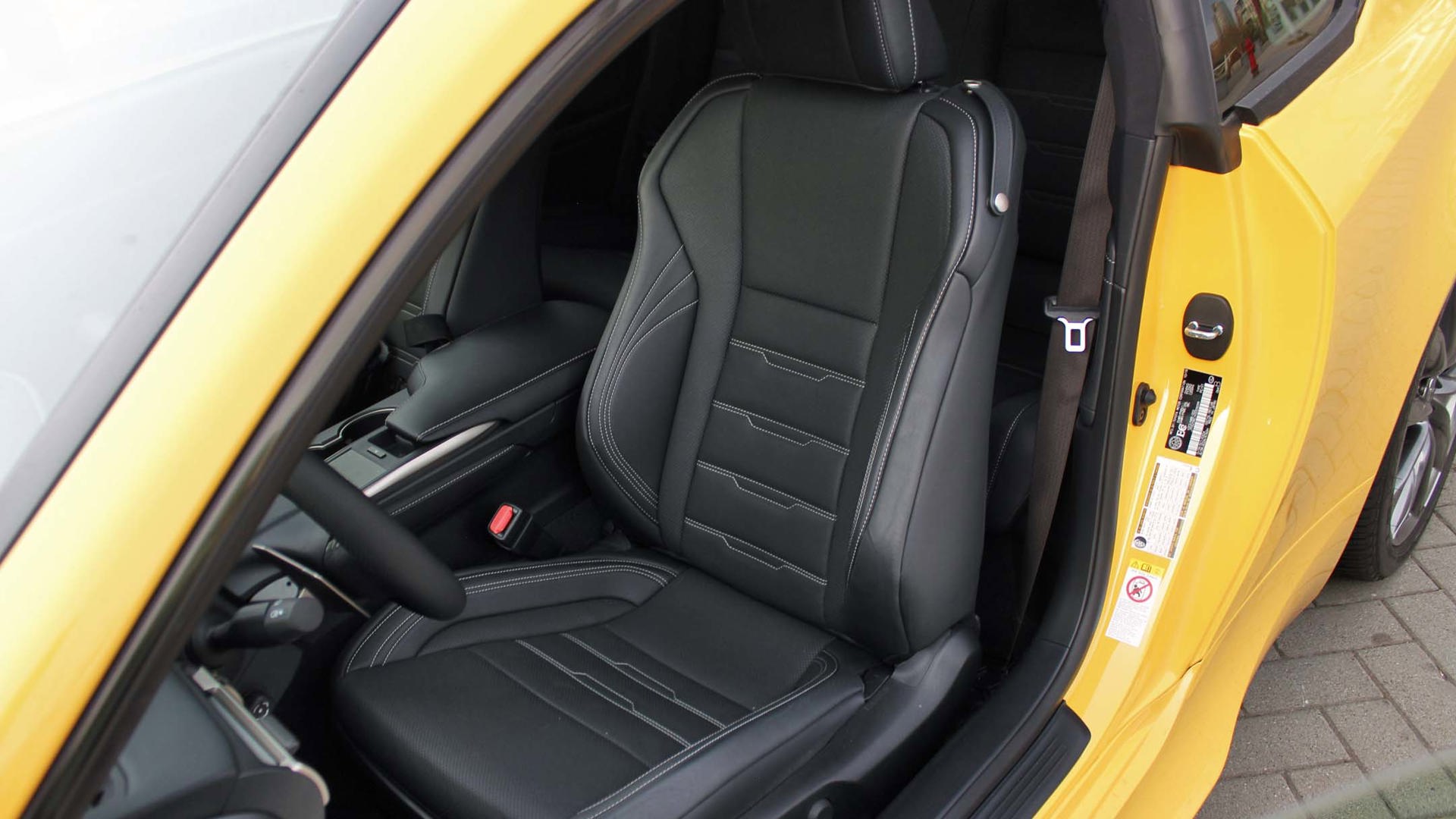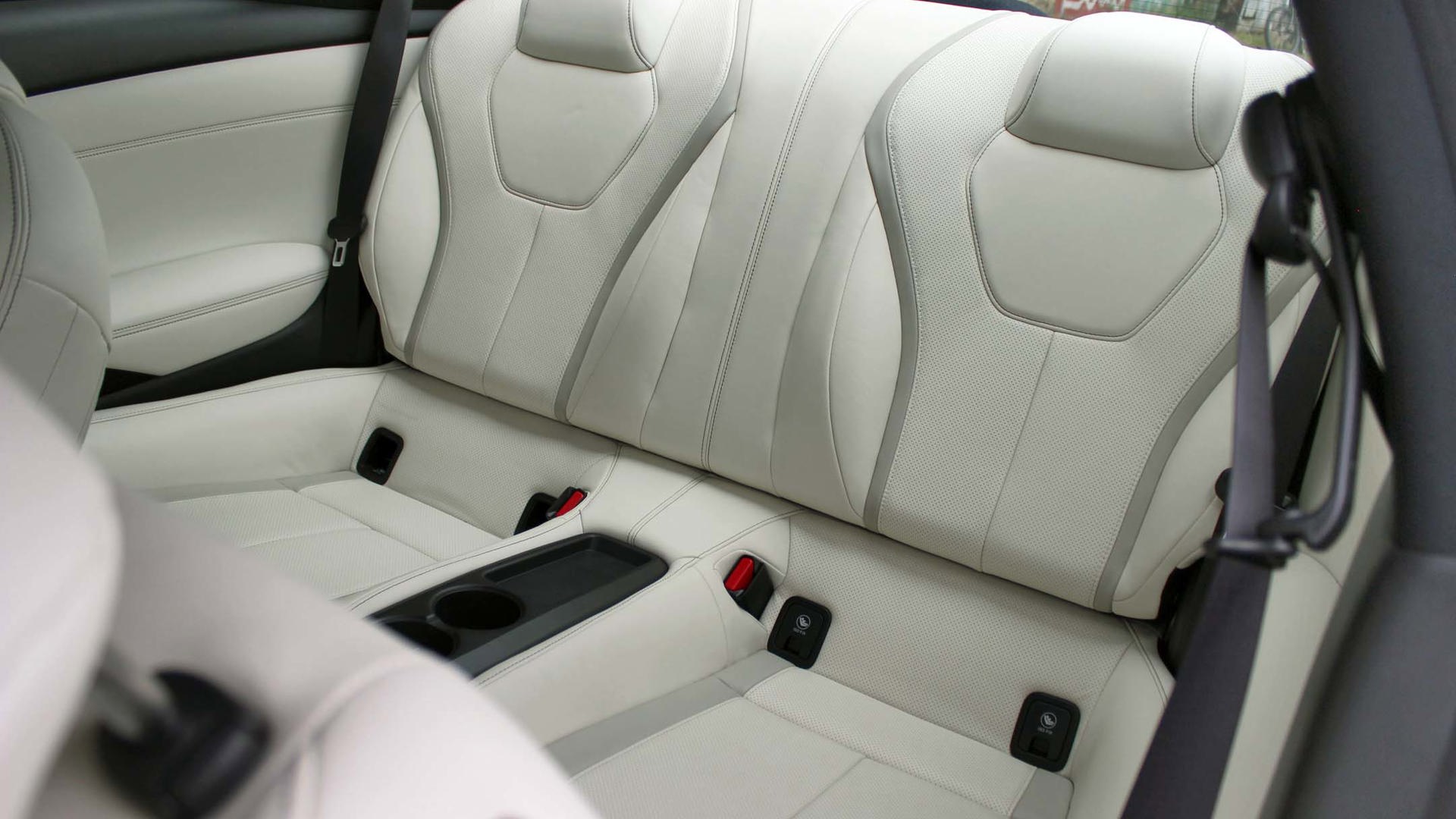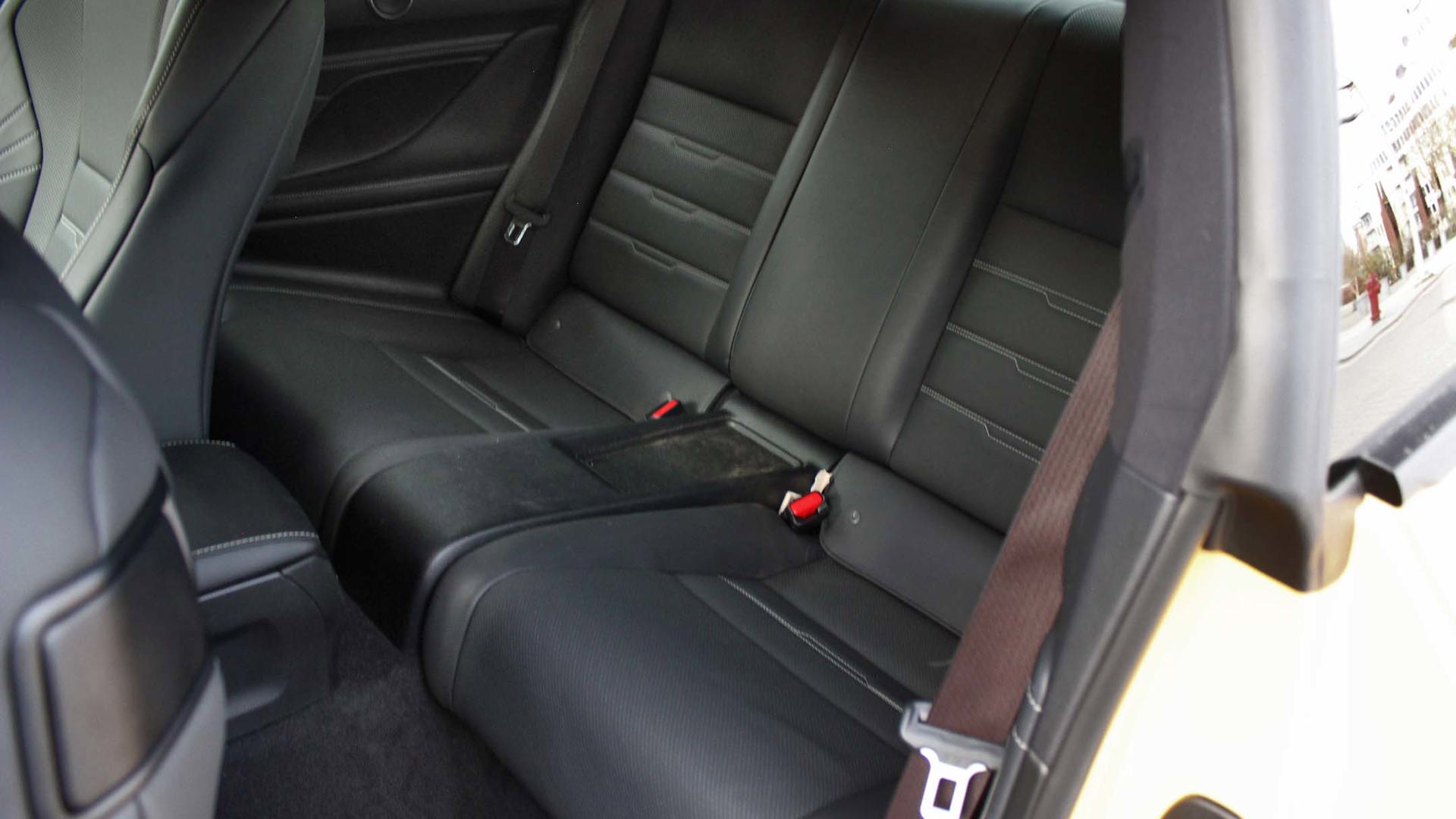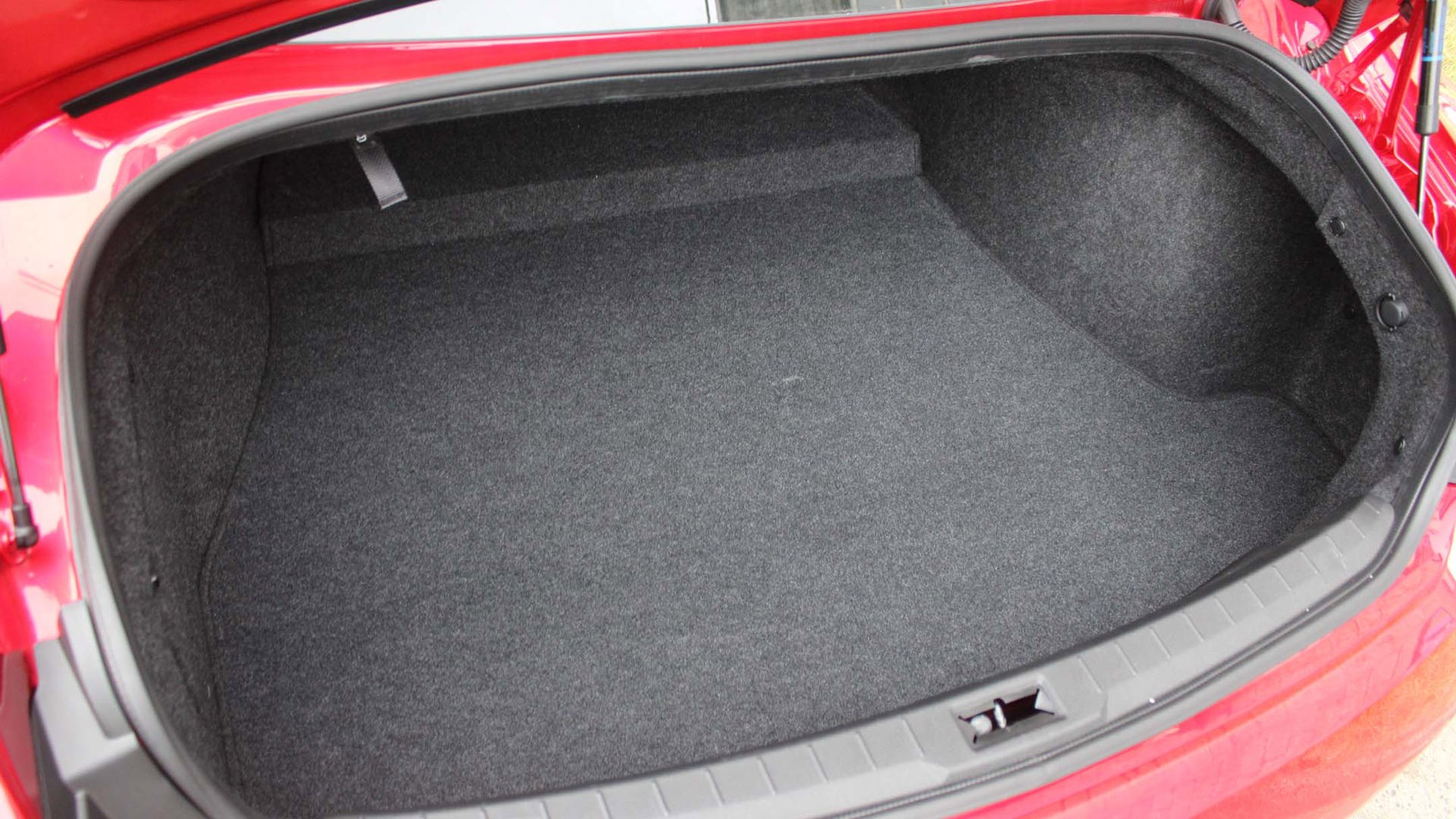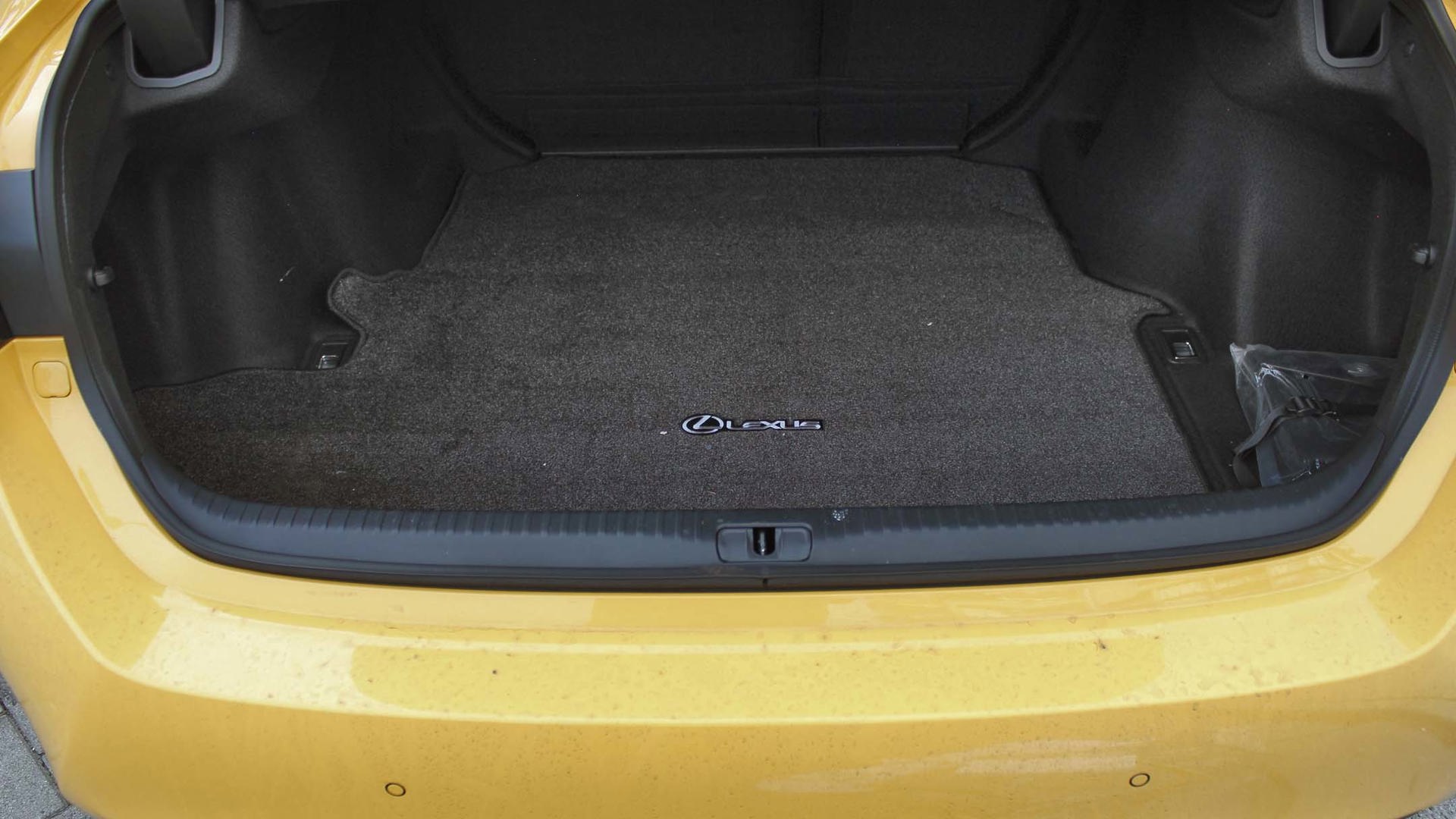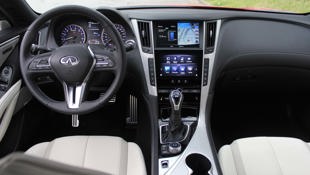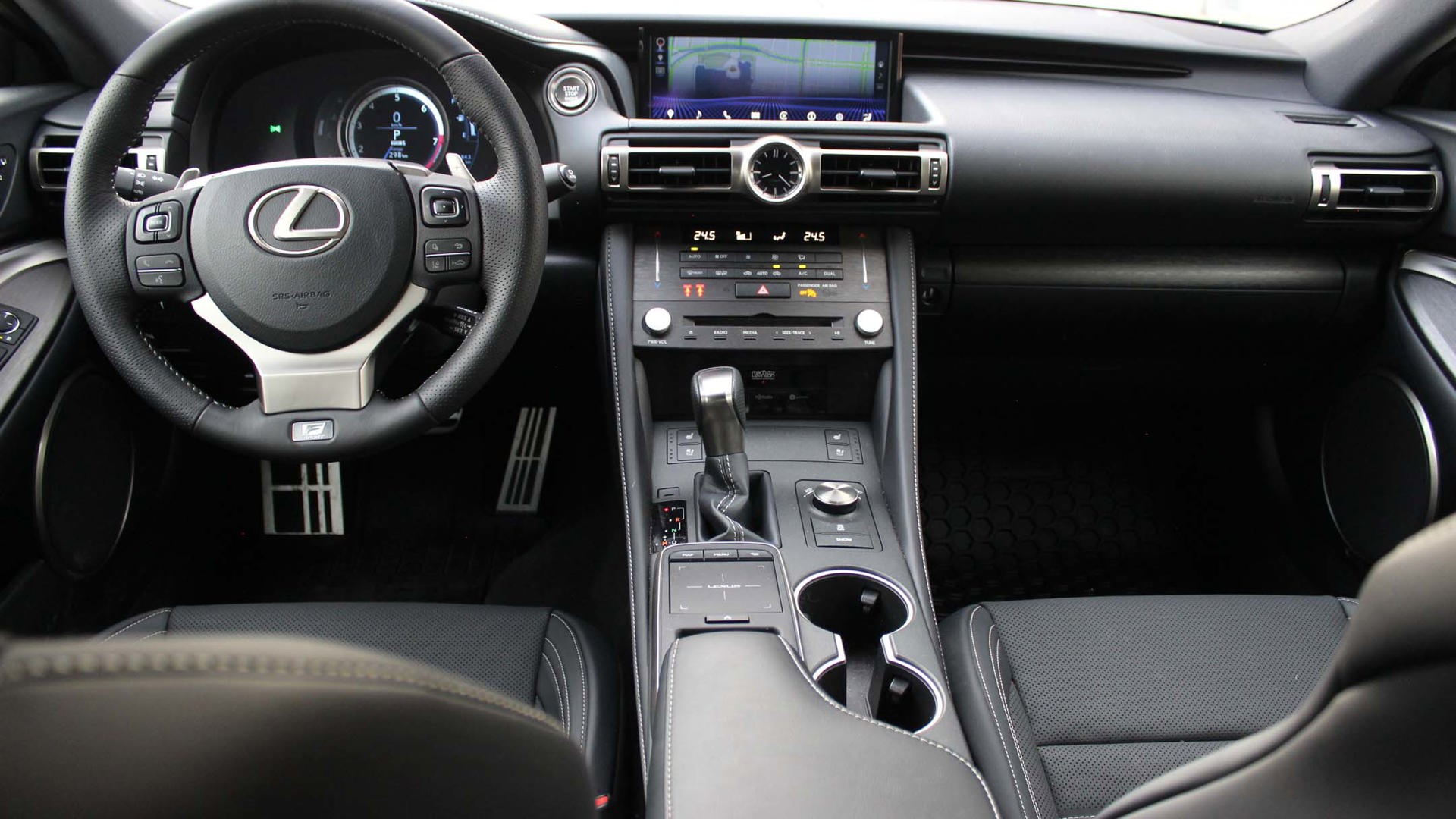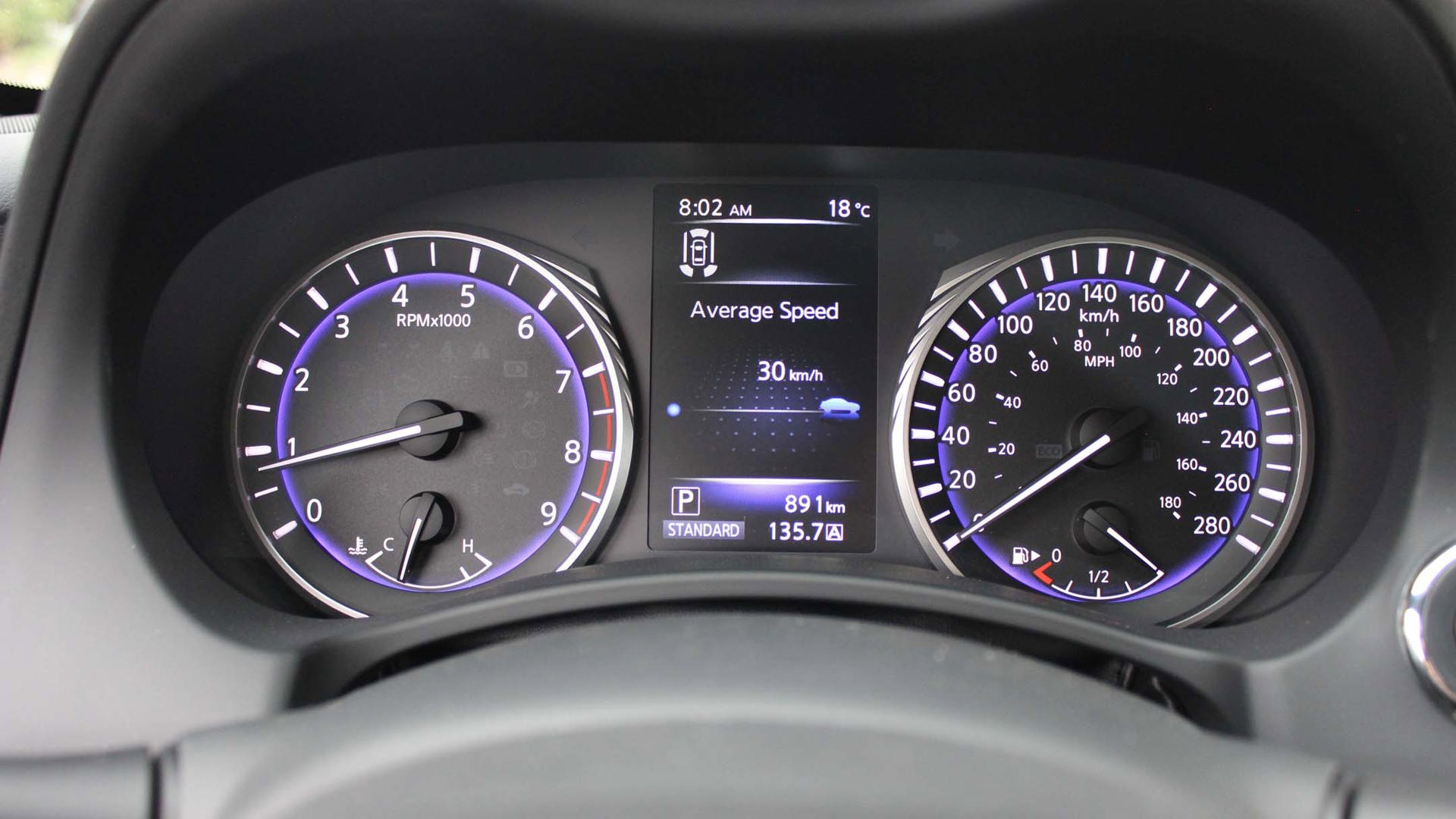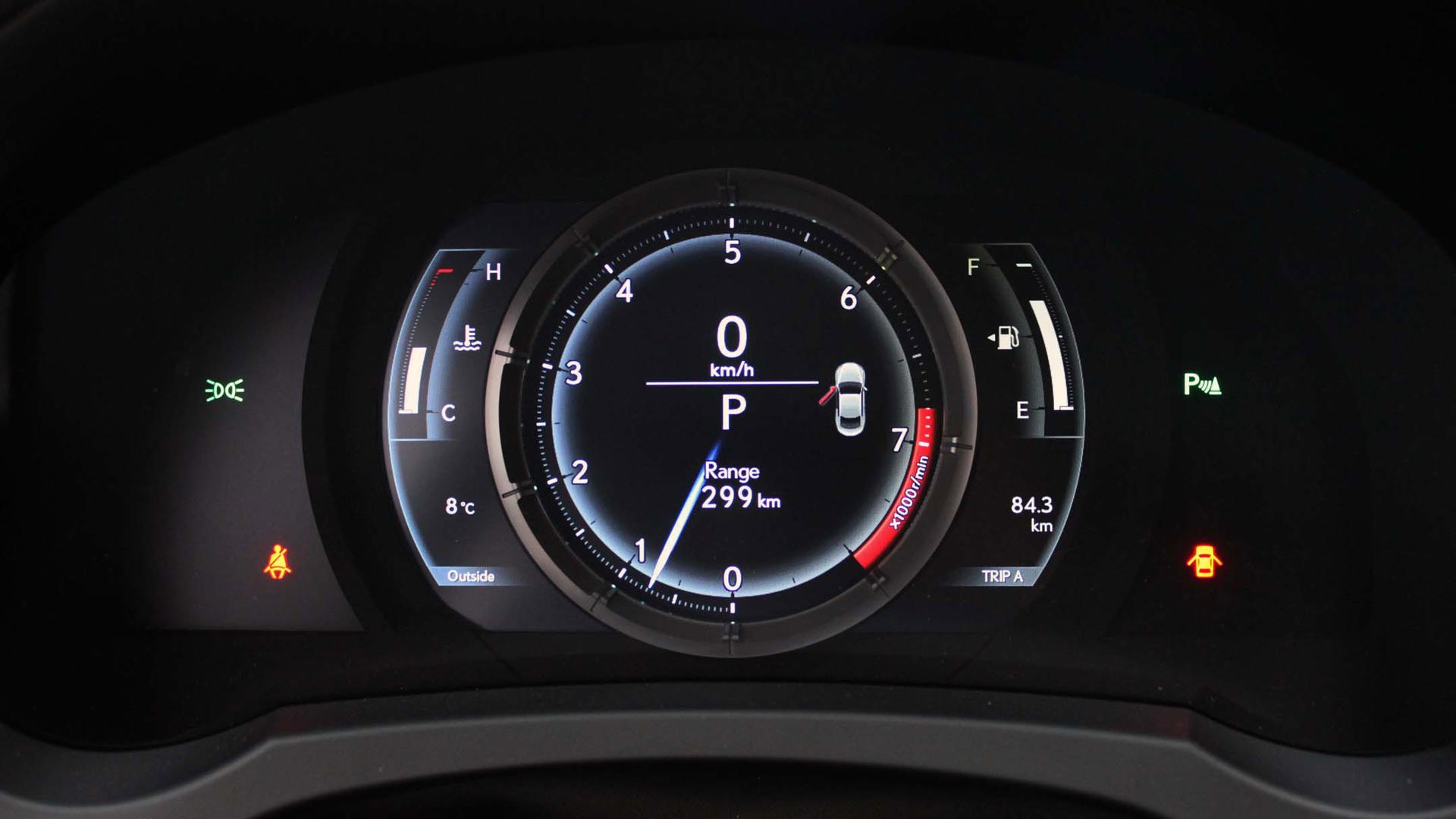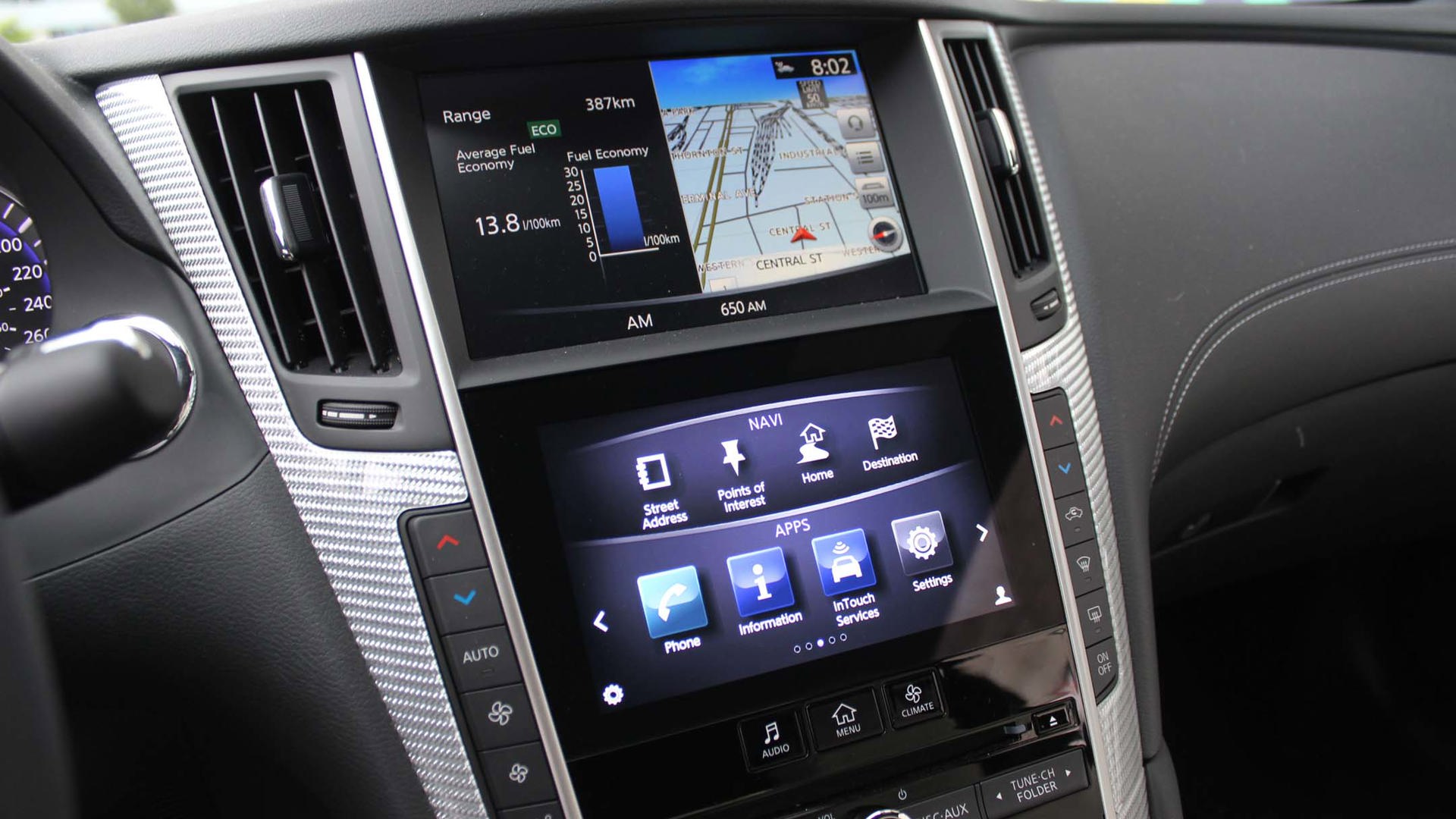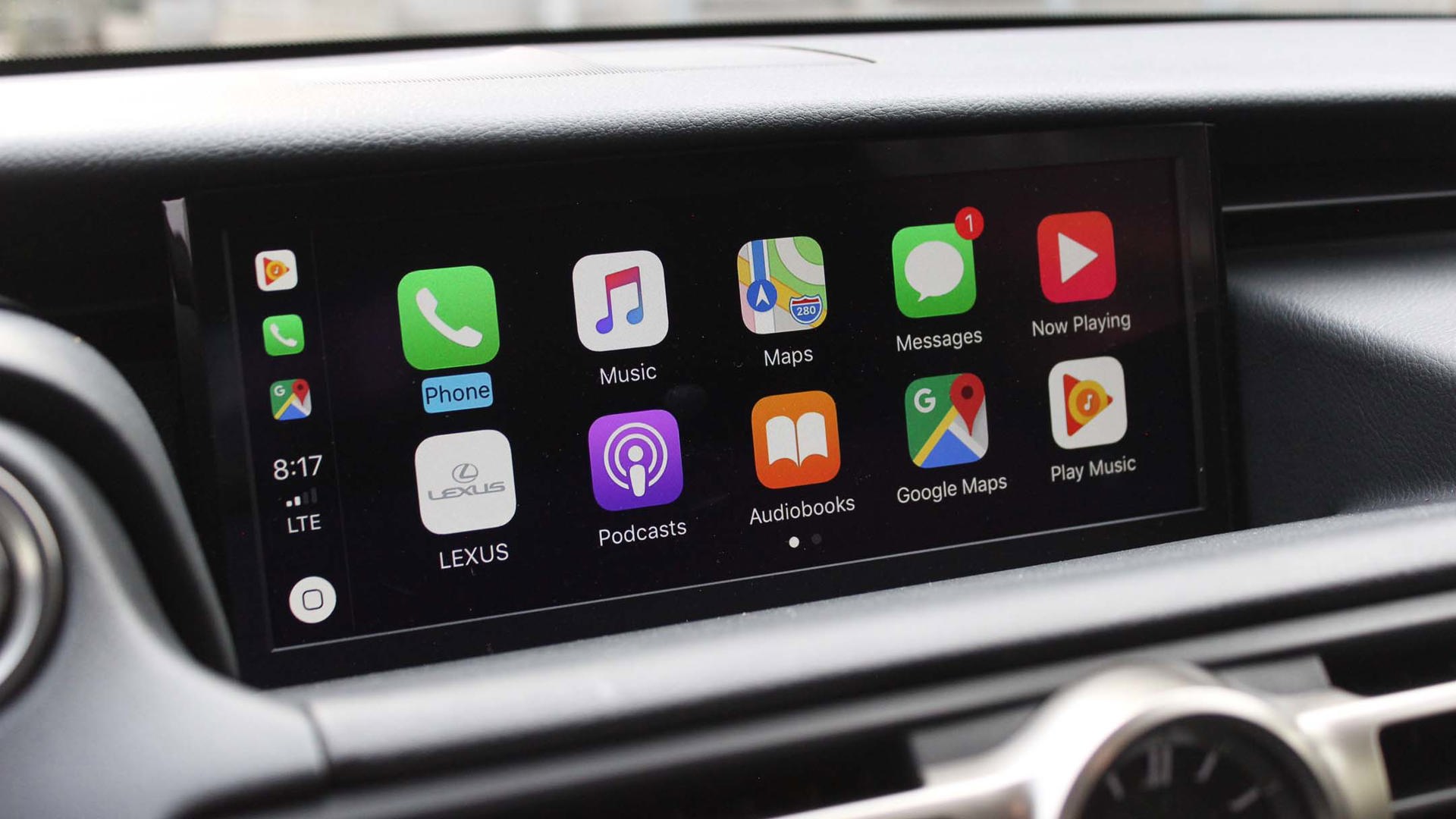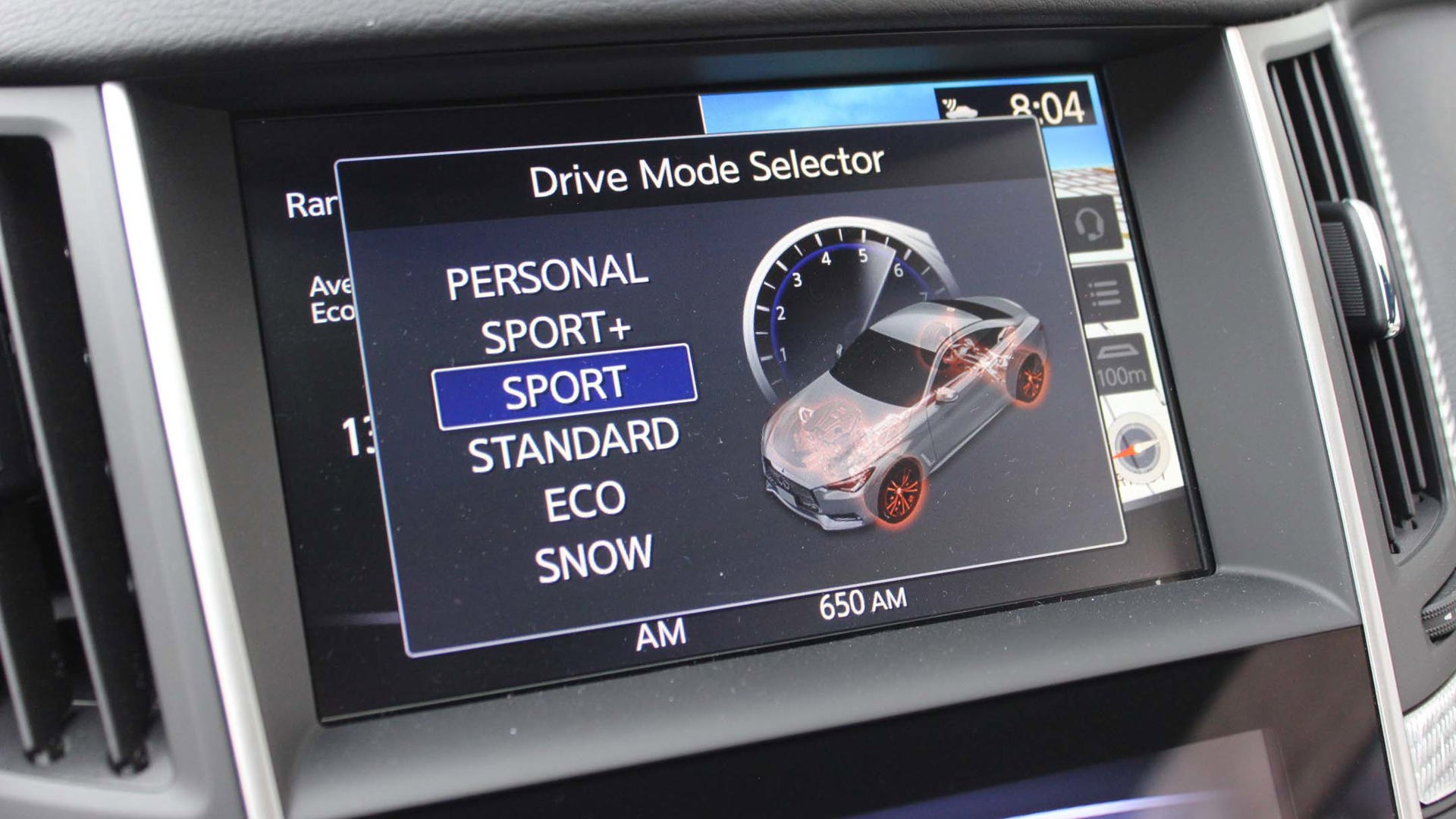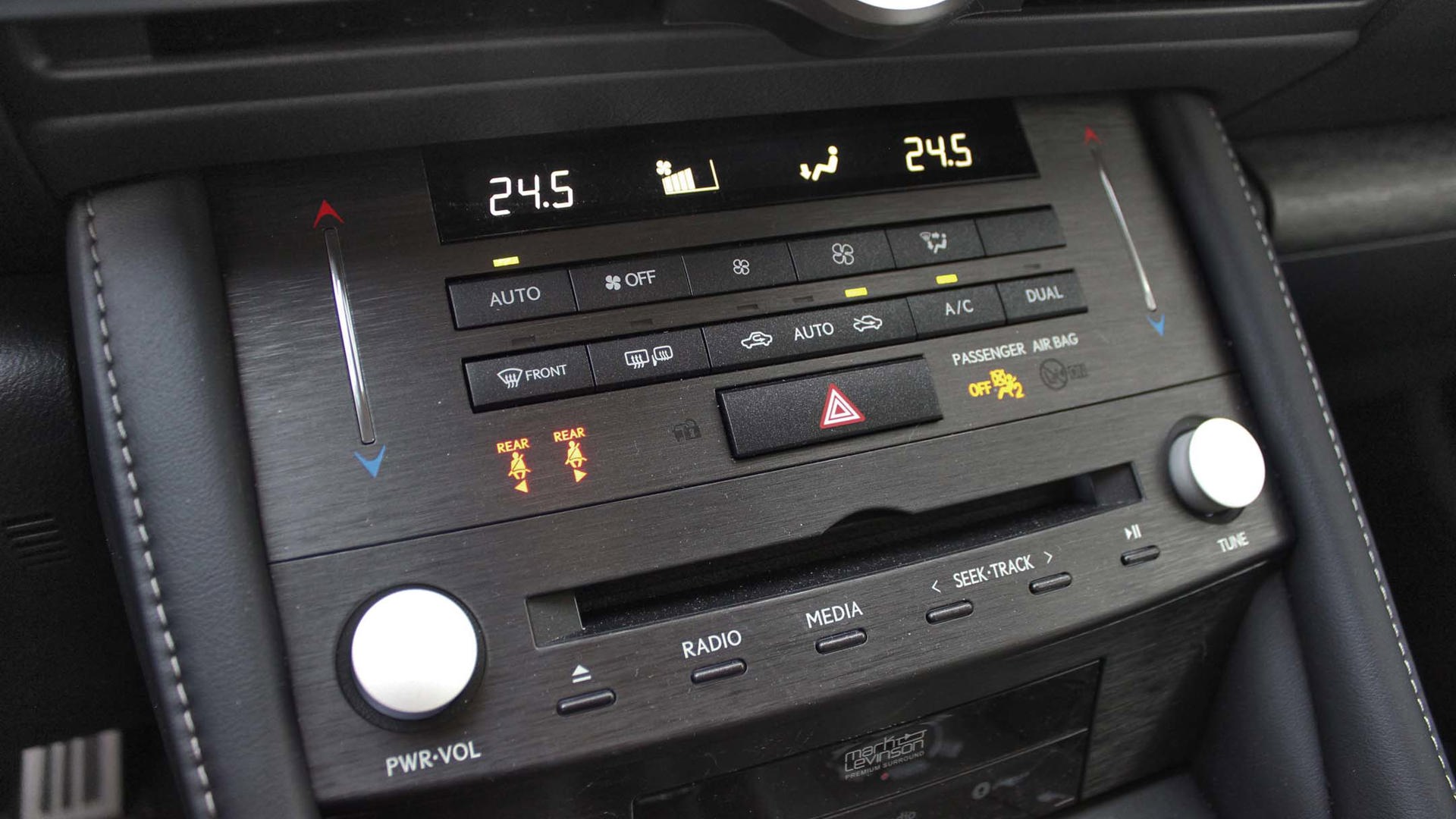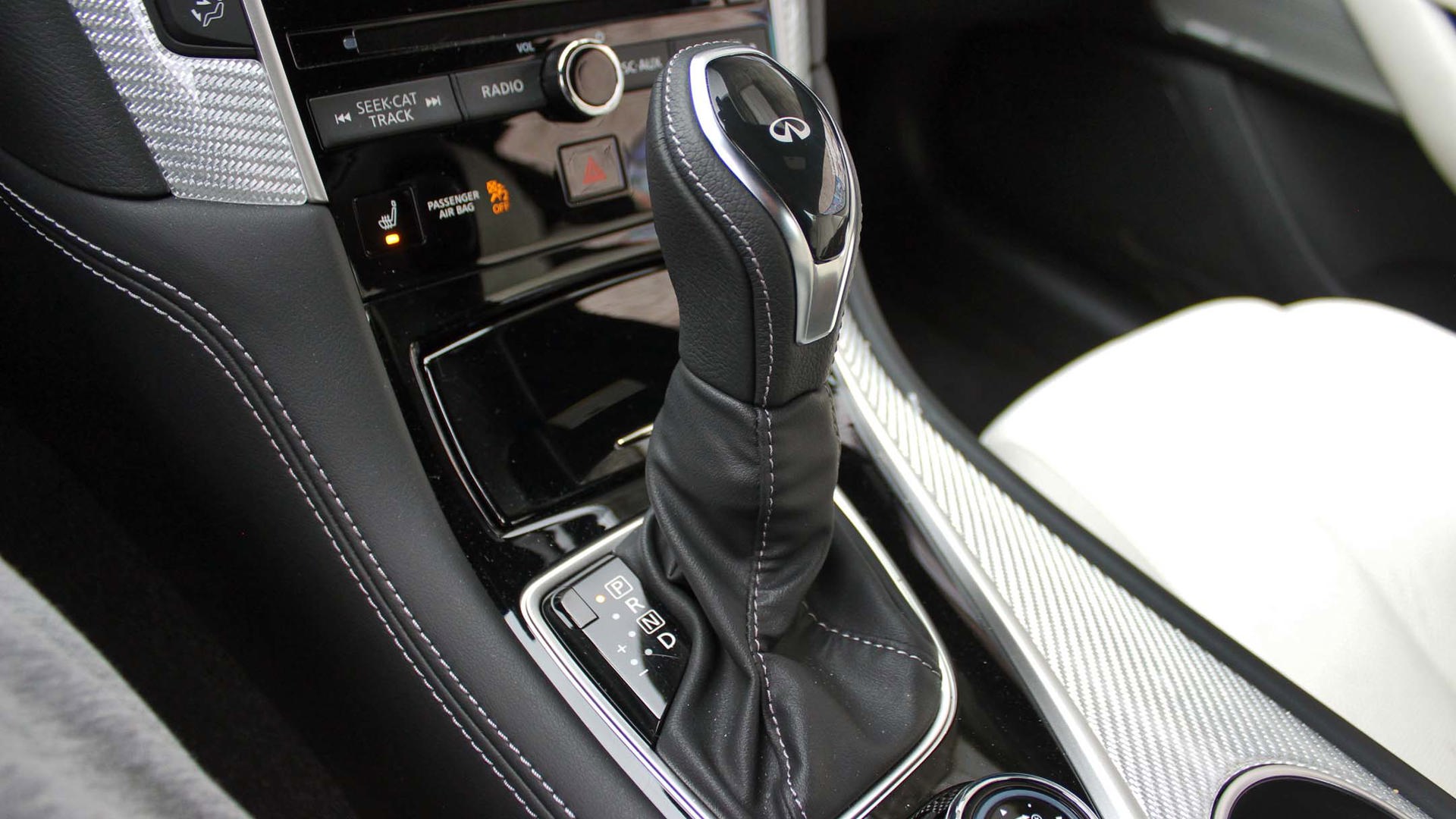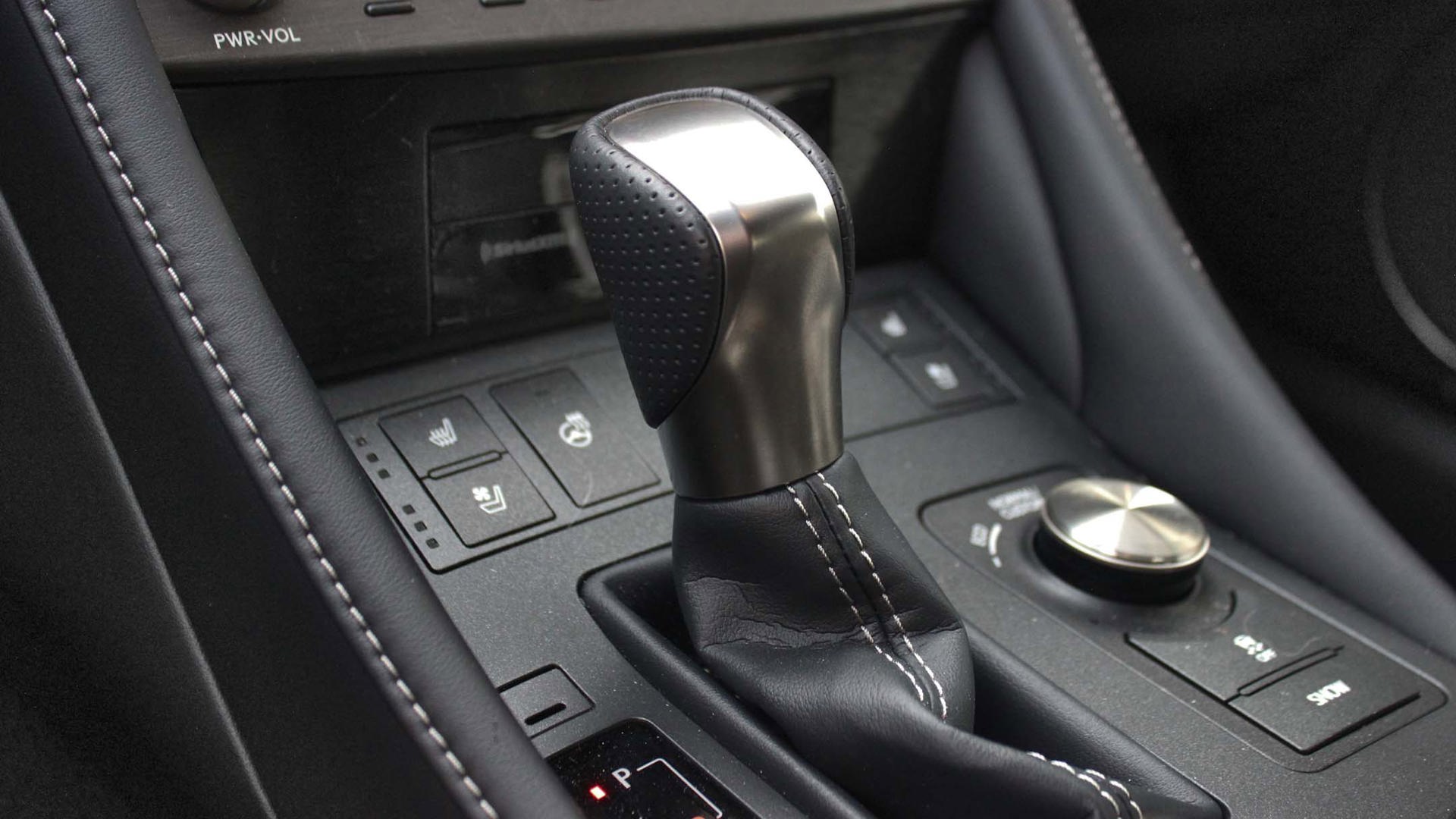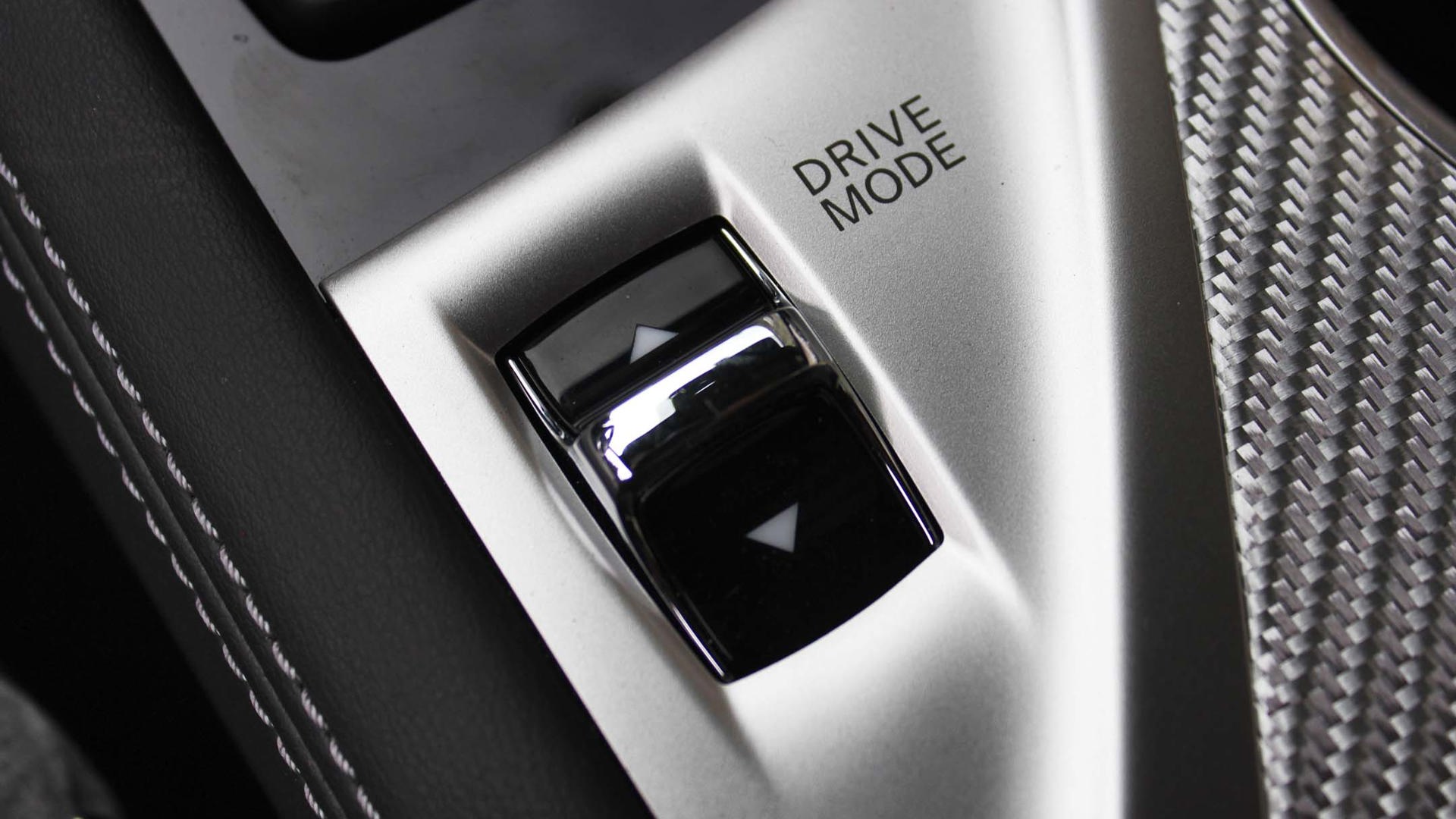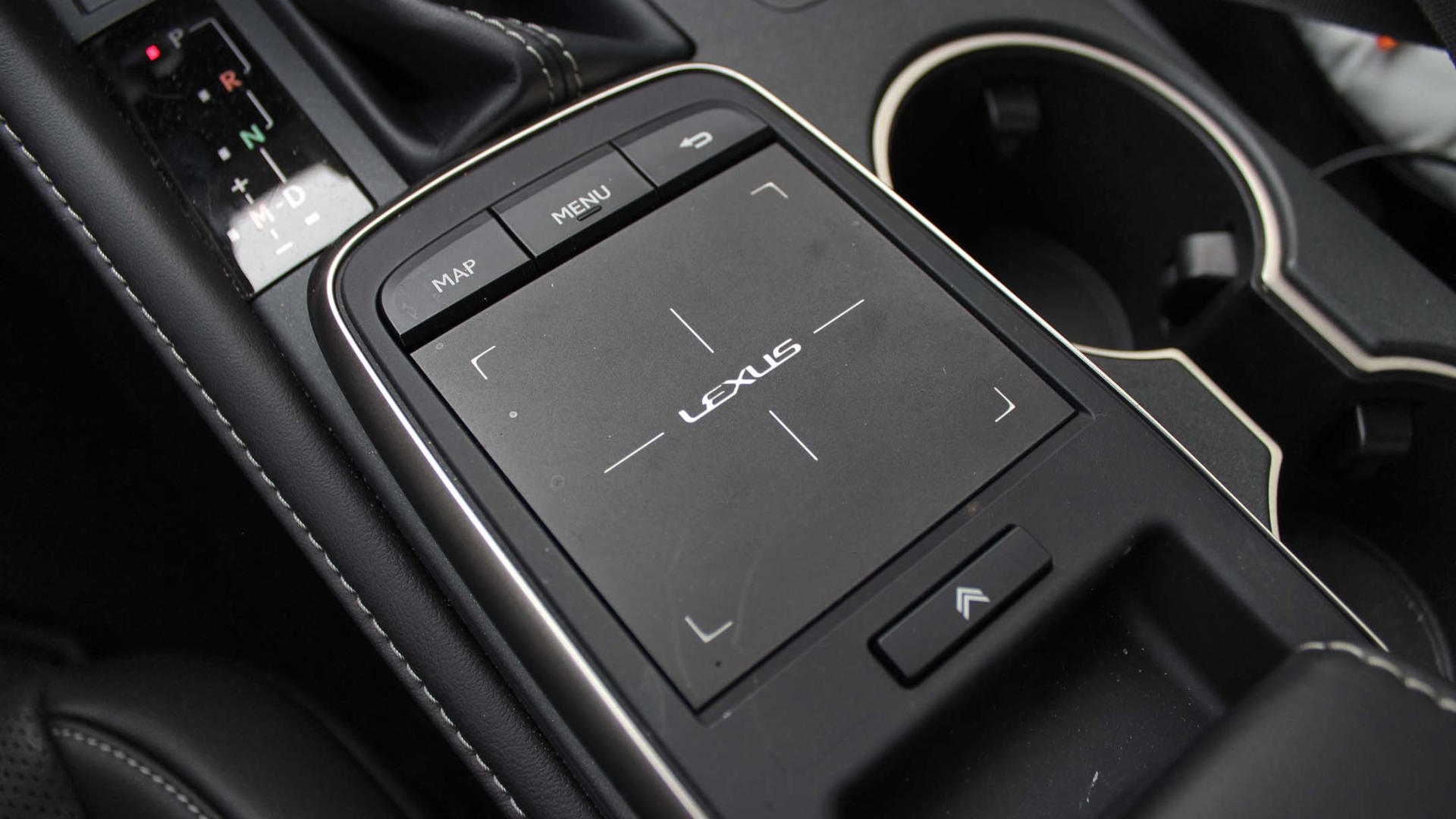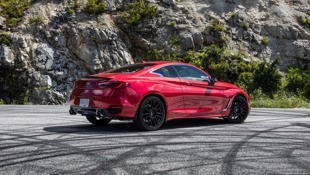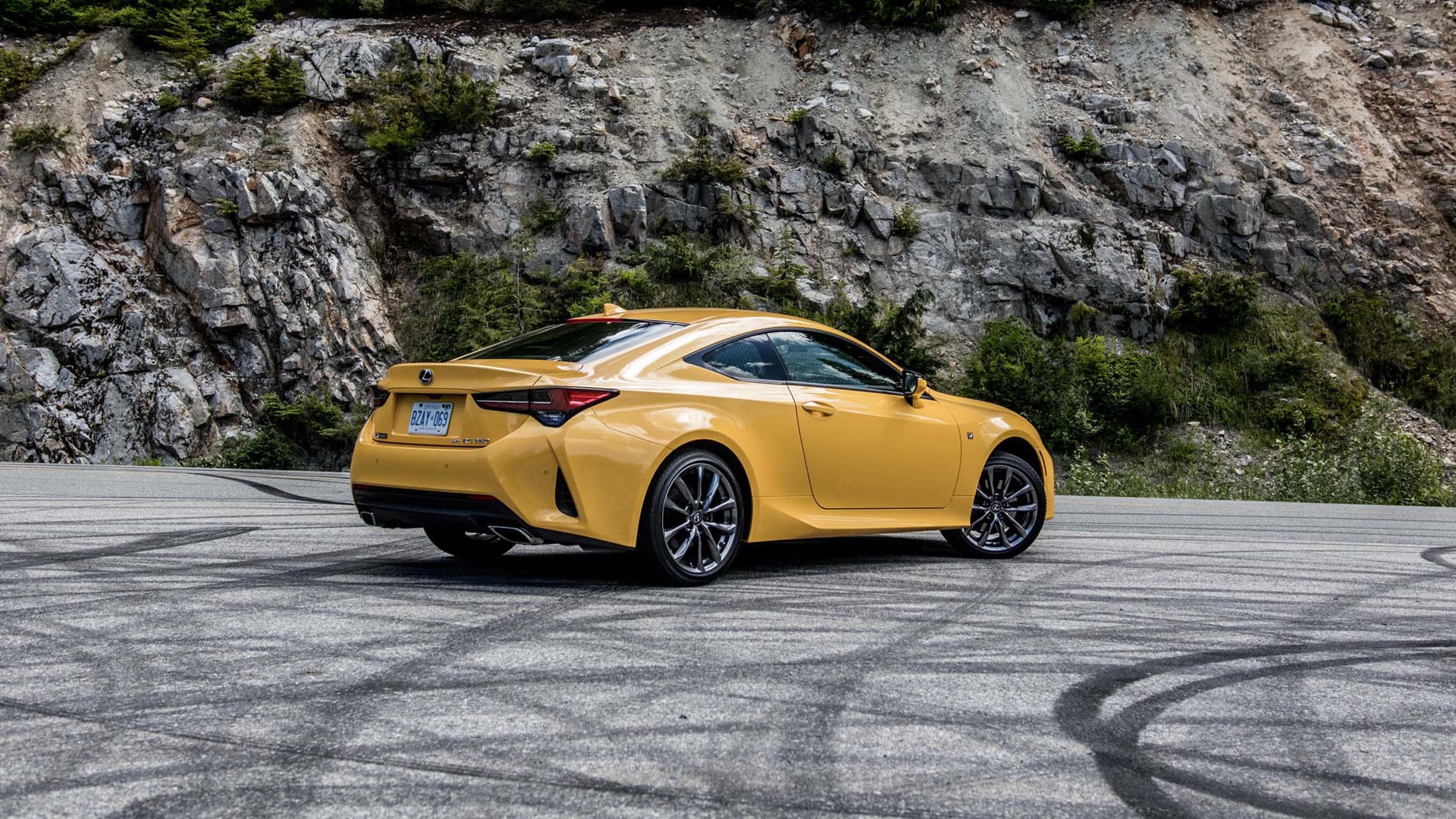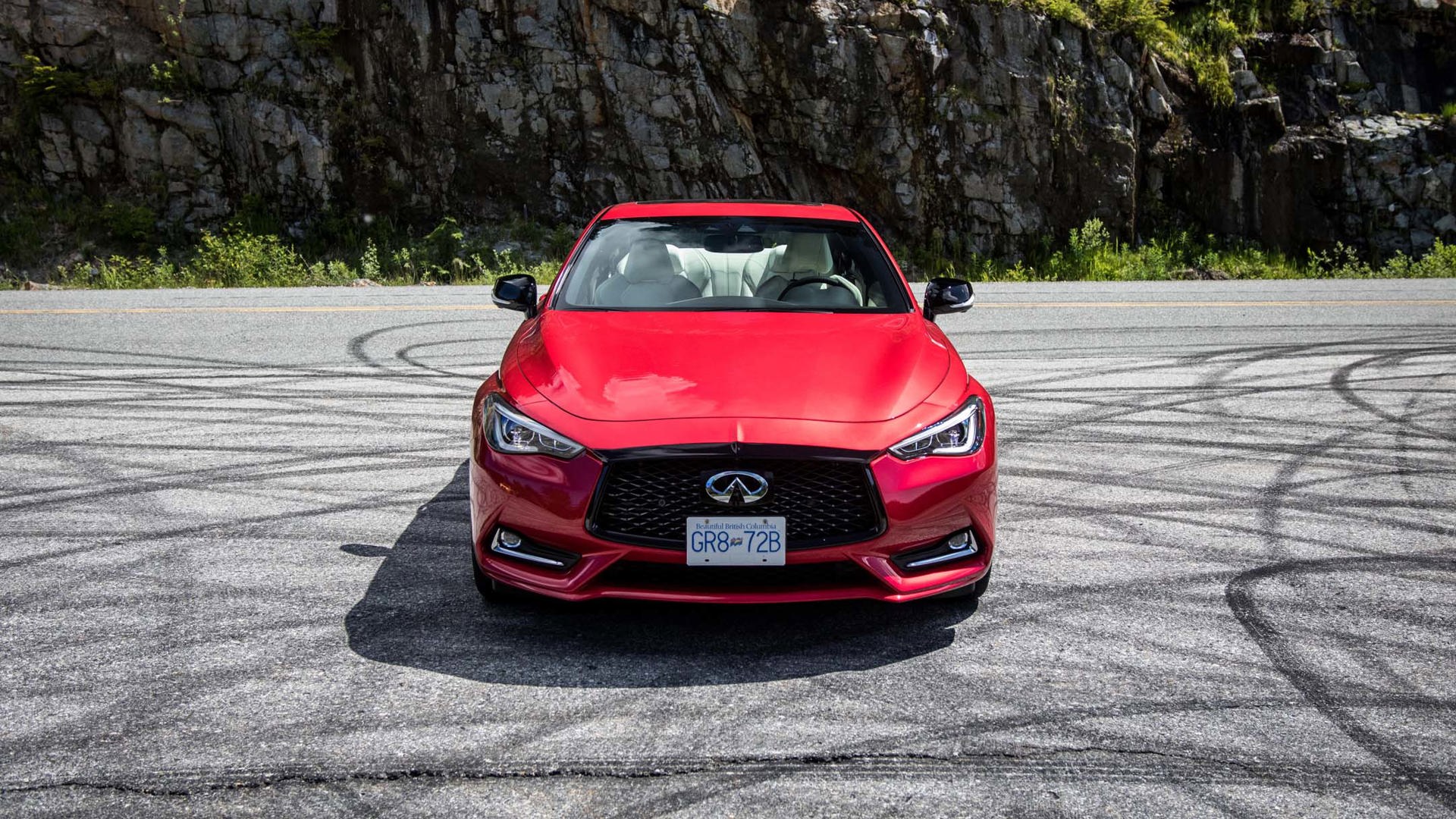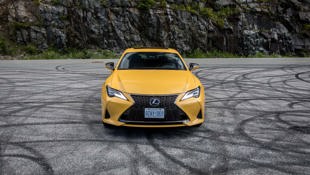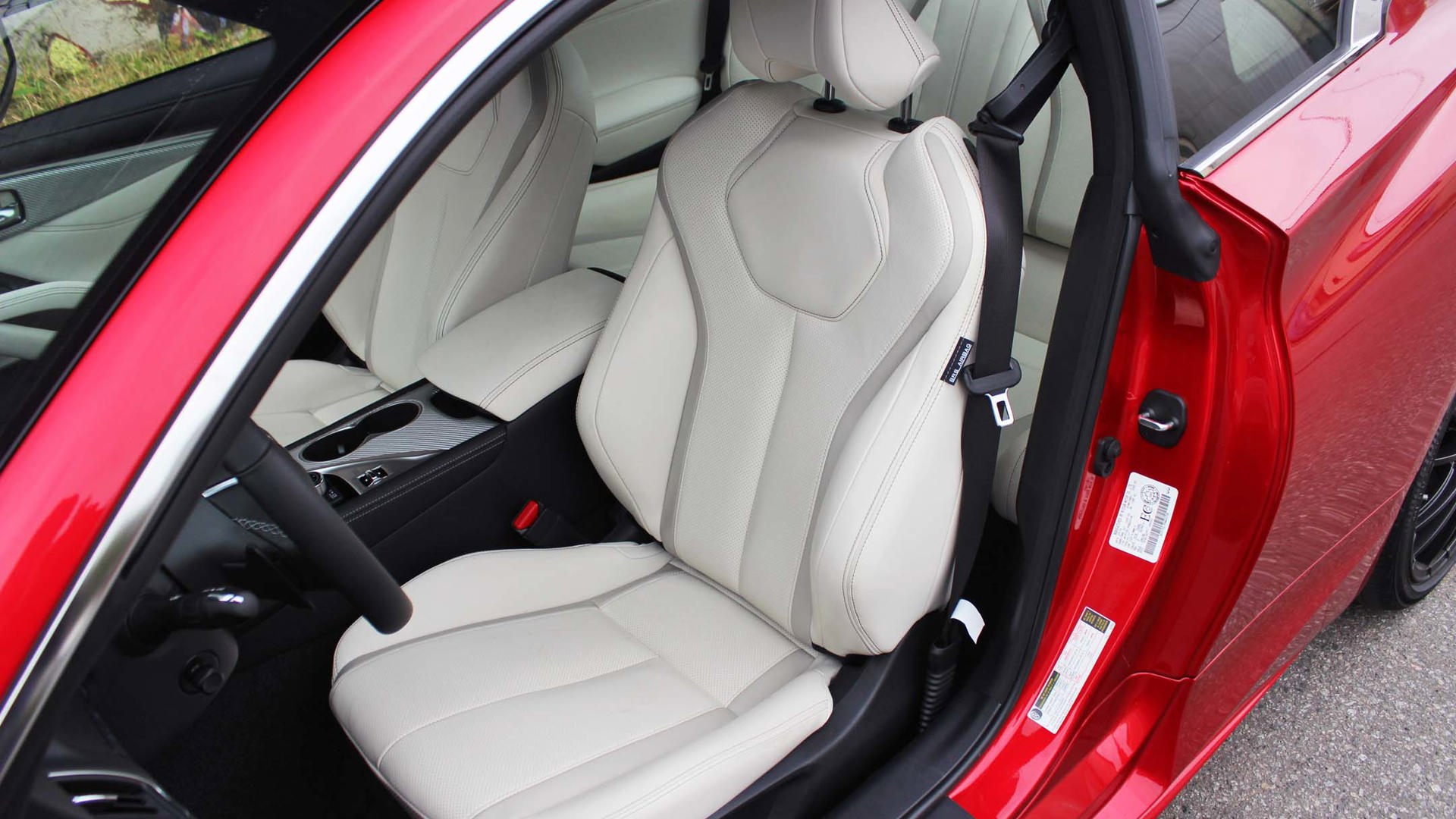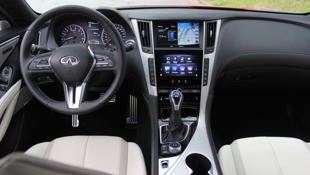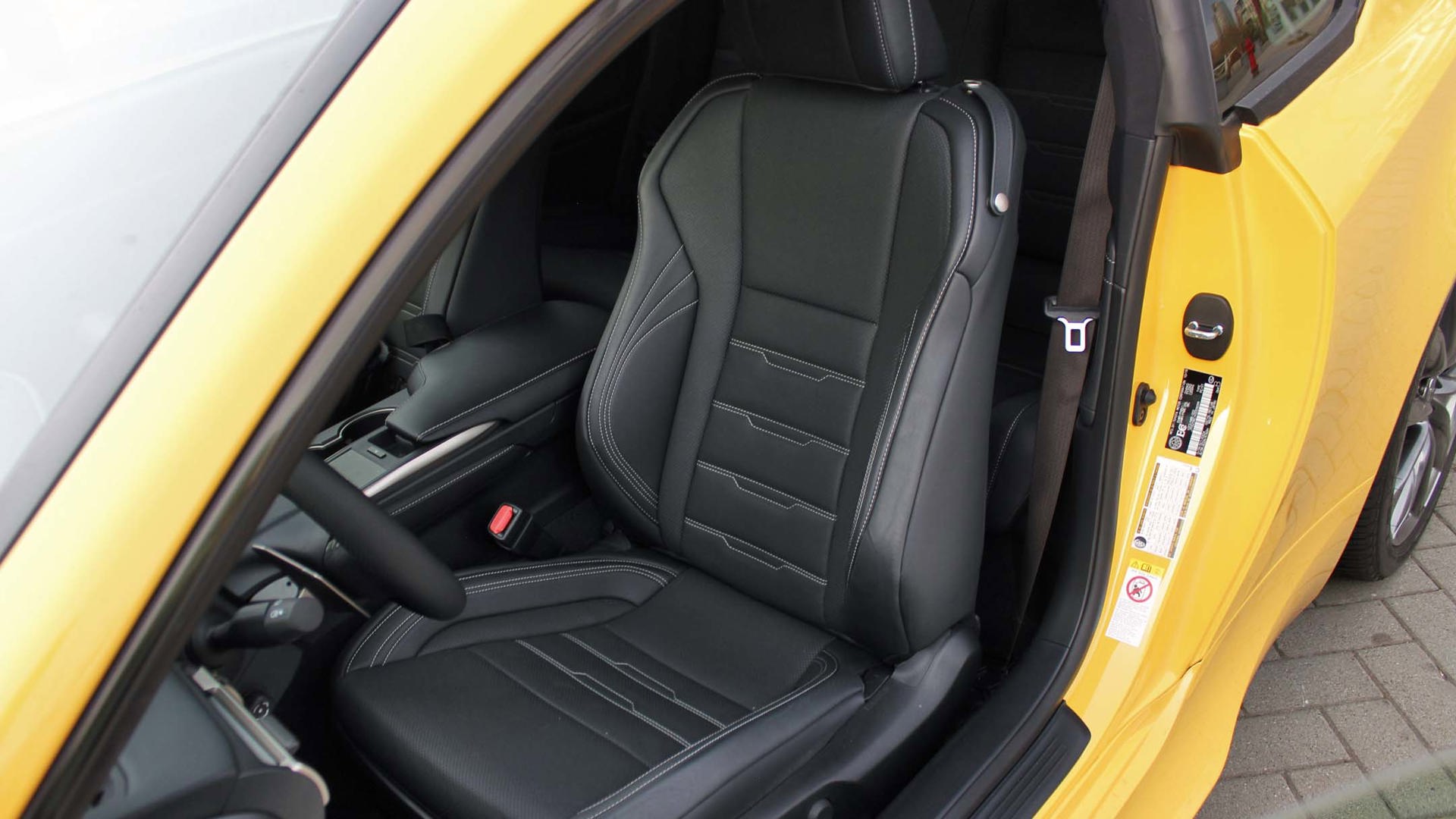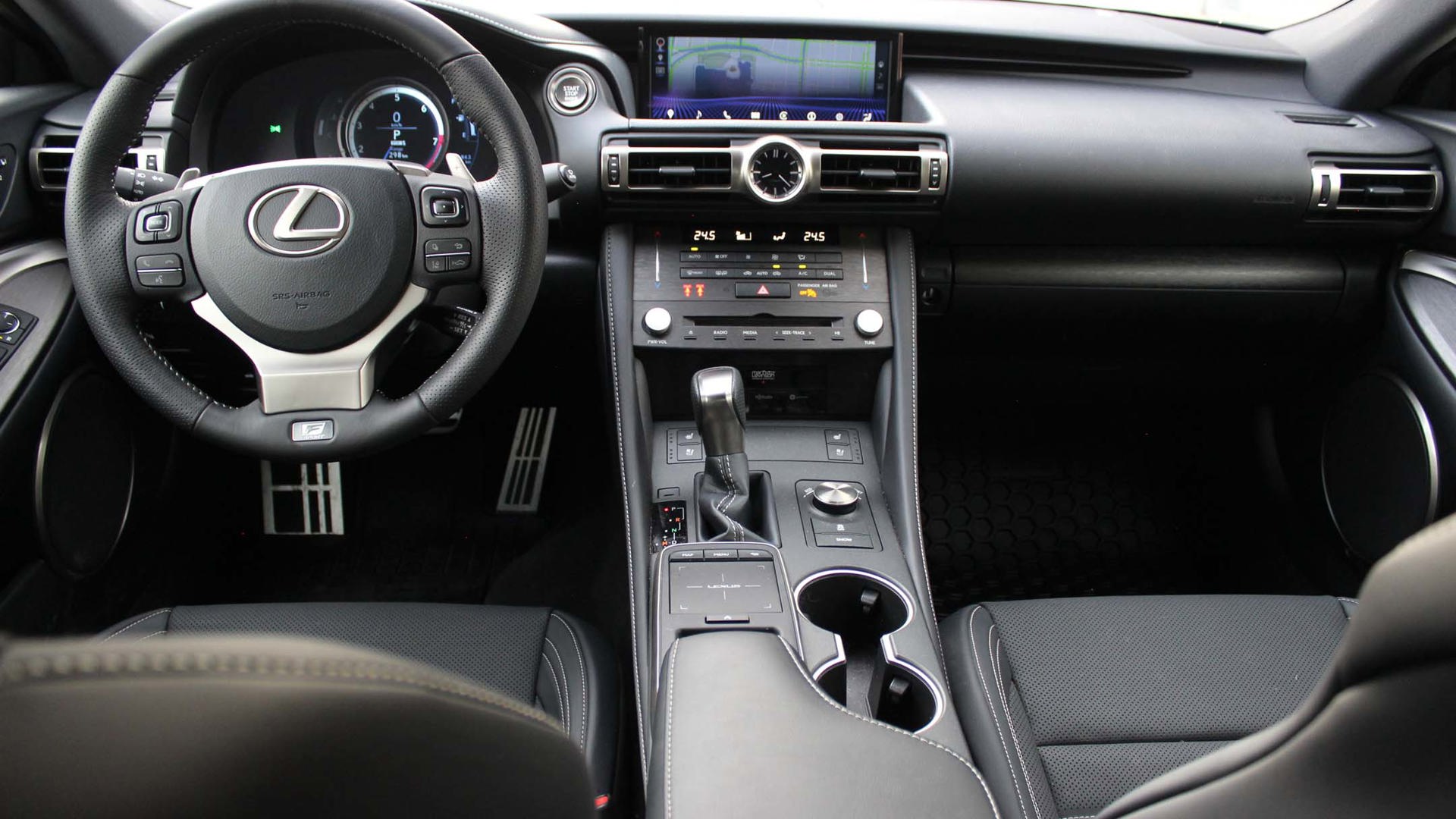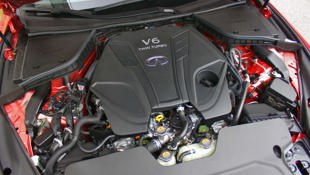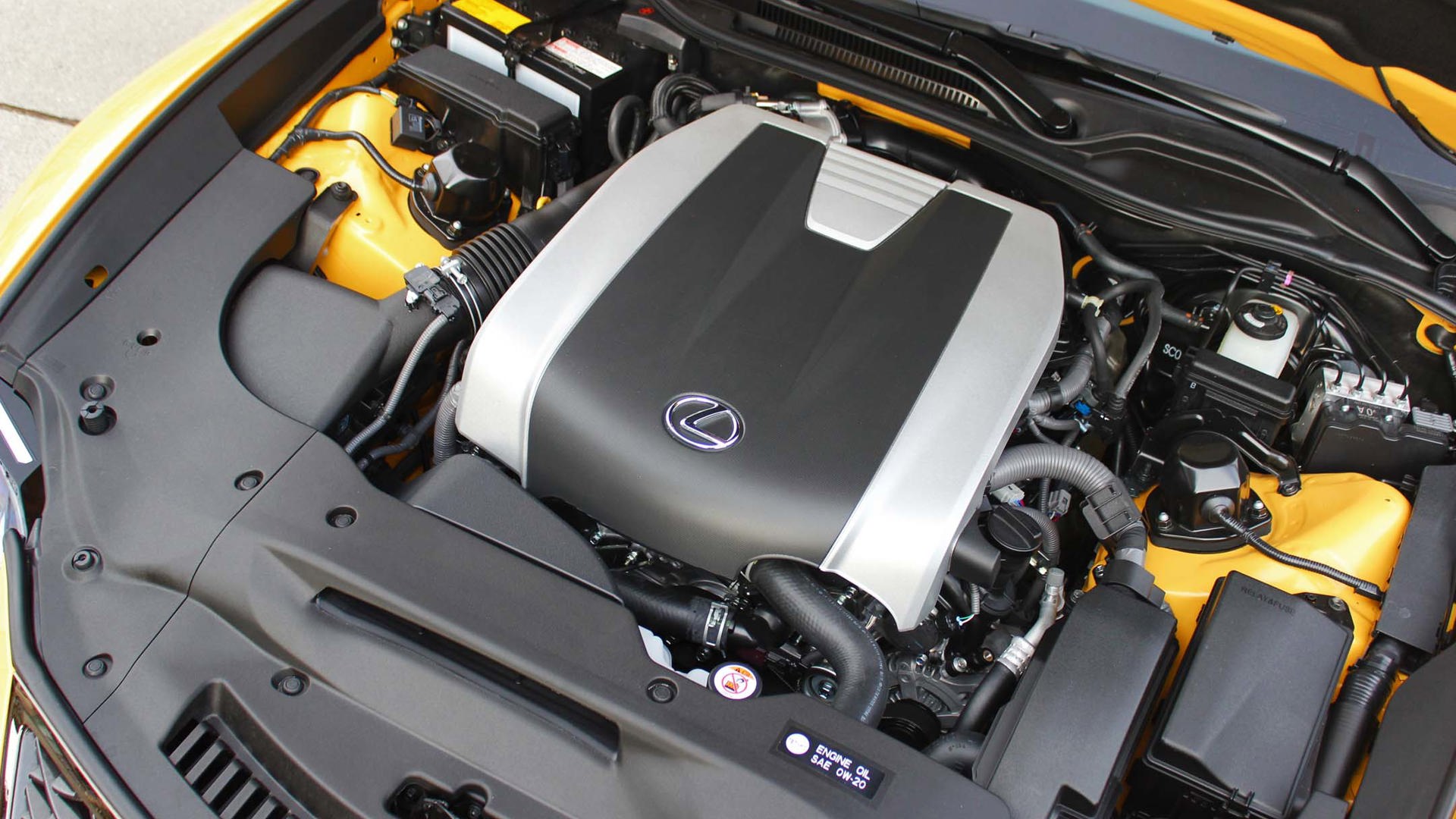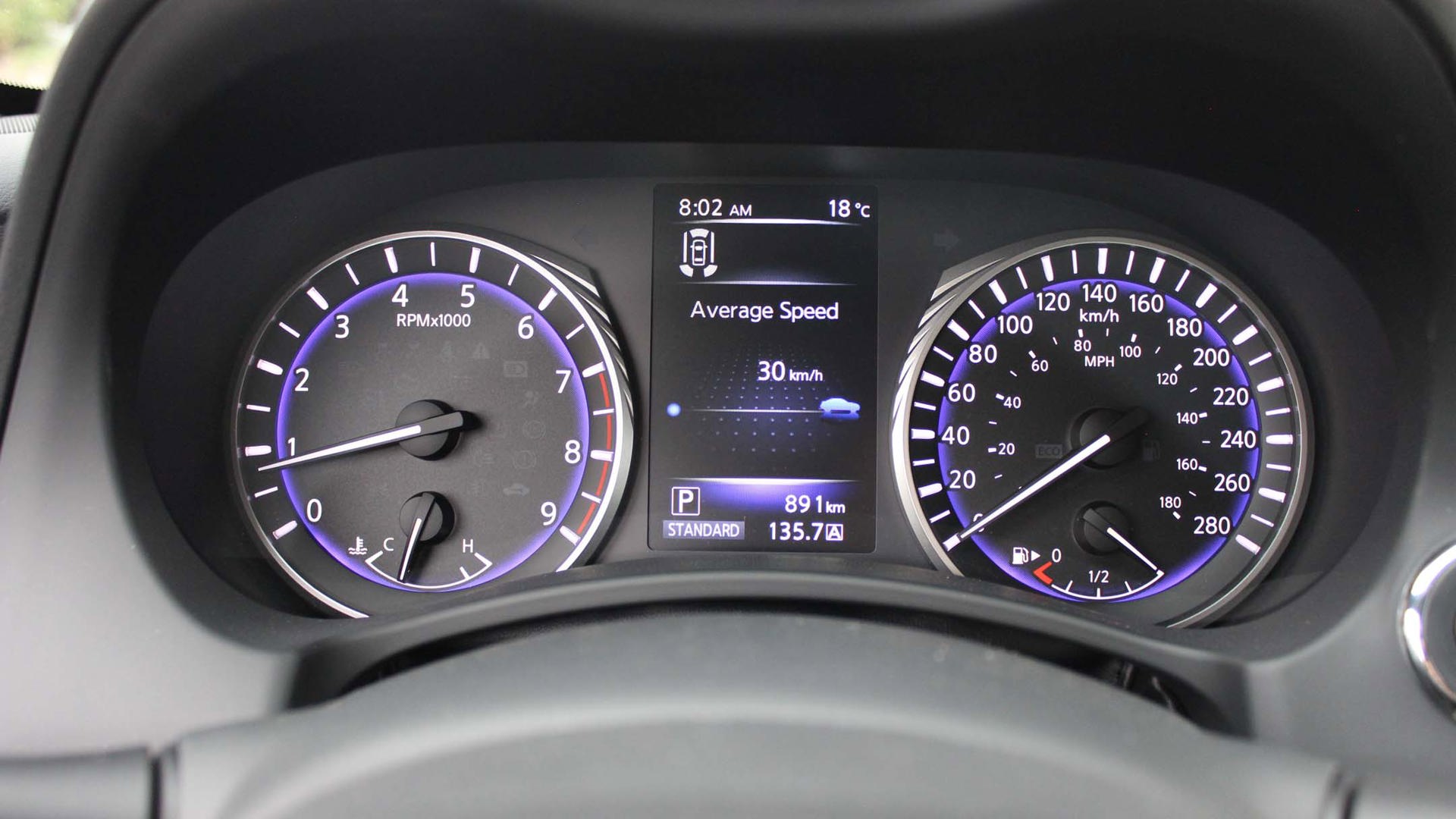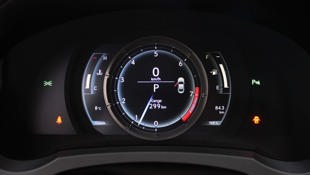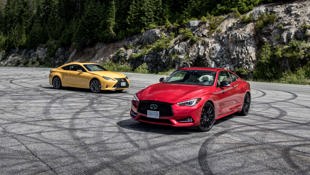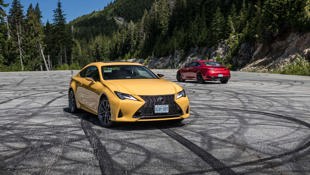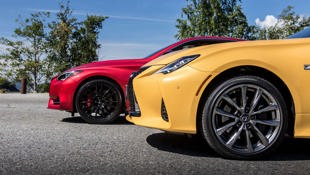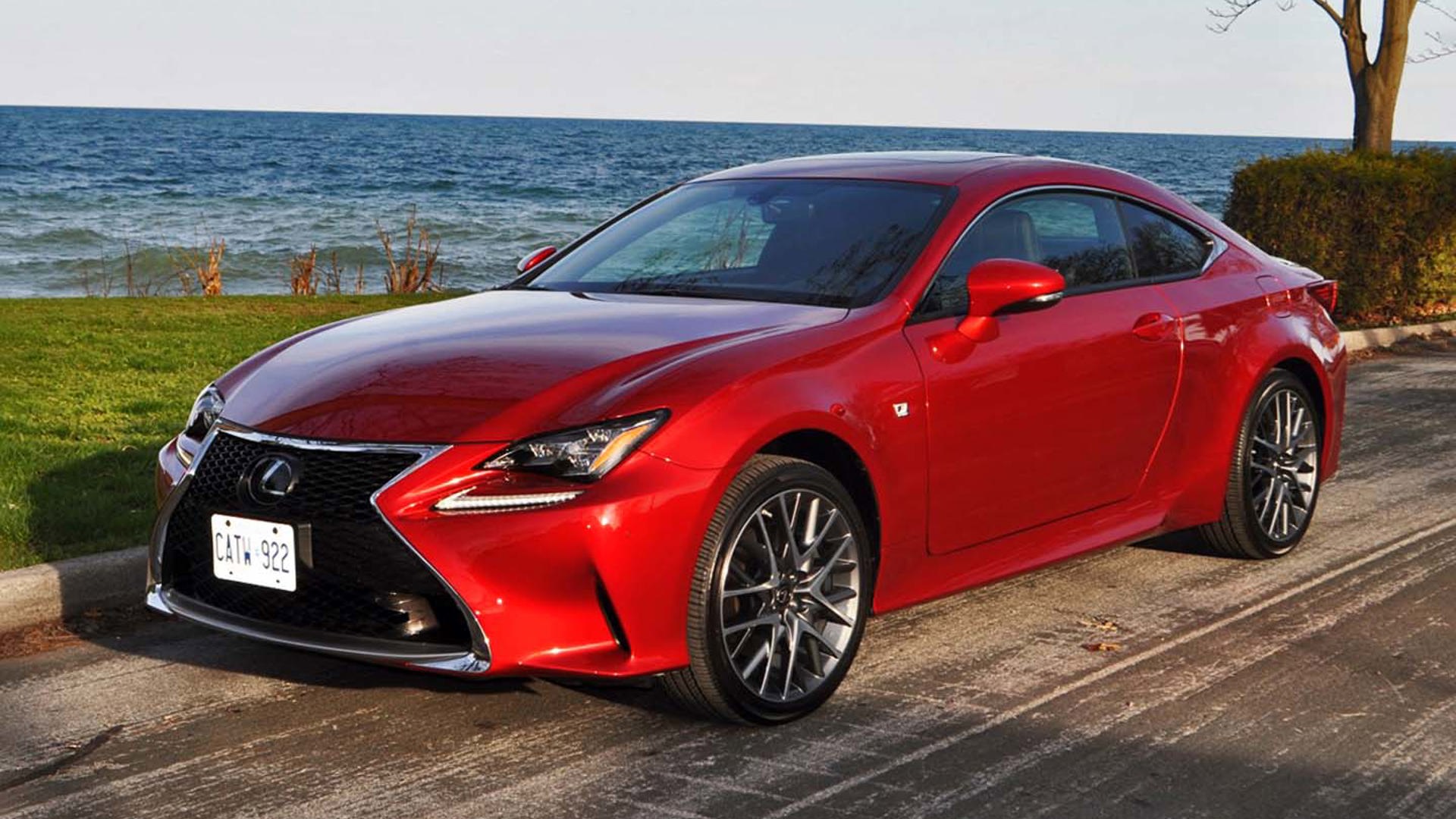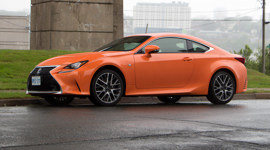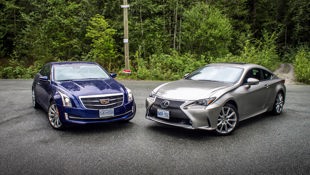Comparison Data
|
2019 Infiniti Q60
|
2019 Lexus RC 350 AWD
|
|---|---|
|
Engine Displacement
3.0L
|
3.5L
|
|
Engine Cylinders
V6
|
V6
|
|
Peak Horsepower
400 hp @ 6,400 rpm
|
311 hp @ 6,600 rpm
|
|
Peak Torque
350 lb-ft @ 1,600–5,200 rpm
|
280 lb-ft @ 4,800 rpm
|
|
Fuel Economy
12.5/9.2/11.0 L/100 km cty/hwy/cmb
|
13.1/9.8/11.2 L/100 km cty/hwy/cmb
|
|
Cargo Space
246L
|
295 L
|
|
Base Price
$62,295
|
$62,000
|
|
A/C Tax
$100
|
$100
|
|
Destination Fee
$2,045
|
$2,075
|
|
Price as Tested
$68,640
|
$64,825
|
|
Optional Equipment
$4,200 – ProACTIVE package (front and rear parking sensors, rear cross-traffic alert, rain sensing wipers, auto-levelling adaptive headlights, lane departure warning, around view monitor, blind sport warning, direct adaptive steering, high-beam assist, intelligent cruise control with full speed range) $3,200; triple coat paint $1,000
|
$650 – Flare Yellow paint $650
|
Story and photography by Dan Heyman and Brendan McAleer
Brendan says:
Welcome to the first annual meeting of the “I’m Not Buying a BMW 3 Series” Club. Oh right, I guess it’d be 4 Series these days. At any rate, here we have two Japanese sport-coupe alternatives to the obvious choice of just buying German. It’s wasabi hot dogs versus currywurst.
Now, it used to be that you wouldn’t even bother with the Lexus in one of these shootouts, as only their V8-equipped F models would be up to the task. Infiniti, on the other hand, has pretty consistently been a sporting brand, with the old G35 coupe being a sort of more-genteel version of the 350Z. Those are the kinds of performance roots to give the Bavarians pause.
However, with these two brightly coloured coupes, everything’s changed up. The 2019 Infiniti Q60 I-Line Red Sport 400 is big, soft, something of a cruiser. The 2019 Lexus RC 350 is aggressively styled, and its F Sport styling draws inspiration from the new track-focussed versions of the RC F.
Dan says:
Oh, how I looked forward to this test. It’s not that I’d never driven examples of these cars before, nor that I’m a JDM-above-all guy or anything like that. It’s just that when it comes time to test a car – or better yet, a pair of cars – that represent a bit of a dying breed, well, let’s just say I’ve often found that’s when some of the best surprises come to pass.
You see, these are two-door luxury coupes, a segment that, in Canada especially, is quickly becoming the only way you can get two doors and a long hood without dropping six figures, and where someone over 5'5" doesn’t have to fold themselves into a pretzel in order to step in. There are of course three muscle cars, a Toyota (recently), and a Nissan available that do the same, but that’s kind of where it ends. No more Toyota Camry Solaras (bad example, perhaps), no more Altima Coupes, no more Accord Coupes – four-door sedans are having a hard enough time selling these days in the face of the SUV and CUV onslaught, and it seems that further reducing practicality against those behemoths by lopping off two doors isn’t helping the situation. Case in point: Lexus sold only about 240 RCs last year, a figure dwarfed by the Q60’s huge count of about 720.
So here we have two bastions of a declining segment that, after driving them, we found perhaps shouldn’t be consigned to such a fate.
Styling
Dan says:
Bright as the Lexus’ Flare Yellow paint is (photos can barely do it justice), it was the Q60 with its Sunstone Red skin and contrasting gloss-black wheels that turned the most heads when we stopped for our photo shoot. It’s not hard to see why, really: the Q60 is the more curvaceous of the two, with a face like a cheetah and the stance to match. In the case of our Canada-only I-Line tester, bonuses like a blacked-out grille and mirror caps as well as a carbon-fibre trunk-lid spoiler serve to kick it up another notch – and the RC to the curb – in the styling department.
It’s not that the RC’s bad; it just that compared to the Q60, it looks like it’s trying a little too hard with all its bumper extensions, chrome jewellery (rims, mirror caps), and of course, that always-controversial Lexus spindle grille. It also looks a whole lot bigger than the Q60, which may be okay for some, but put side-by-side, the Q60 looks more performance-oriented.
Brendan says:
Hoo boy. I am not a fan of how busy the styling on the RC is. It’s not so much that they’ve done too much here, it’s that the audacity of what Lexus is trying to do doesn’t quite translate to the mainstream. The flagship LC coupe? Now, that big dreadnought can pull off extreme angularity. With the RC 350, you start noticing the faux air channels out back and it’s all a bit too much costume jewellery.
As for the Q60, there’s a few nits to be picked here as well. The side-badging, for instance, is a bit of a mash of different fonts and text sizes. But this is just prodding at the details, as the Q60 really is just a big handsome machine. I really like Infiniti’s curving styling, and if the huge exhaust tips are a bit juvenile, then the rest of the design has matured nicely.
Interior
Dan says:
Quite the contrast here, and it extends beyond each car’s interior colour swatches – literally a black-and-white affair. I’m talking more about the detailing, which pretty much revolves around one thing in the Q60, and that’s the silvery carbon-fibre inserts draped over the centre stack, console, and door cards; they’re just a little much. It doesn’t look quite high-class enough for a luxury coupe like this, but more like something non-luxury manufacturers might do to “sportify” the interior of their compact hatches and CUVs. Luckily, there are some slightly less lurid interior treatments to choose from.
The Lexus, on the other hand, is all business; dark colours, yes, but it’s classier and more becoming of what this segment is about. It’s not especially exciting to take in – some may say it looks just a little old-fashioned – but you notice details like the brushed aluminum inserts on the centre console more out of the corner of your eye, instead of having them fry your retinas like in the Q60. It’s that subtlety that lends an extra air of classiness.
Brendan says:
On the inside, the Q60 and the RC 350 swap their exterior demeanours. The all-business Lexus is much tidier and feels better assembled. Yes, the all-black treatment is a bit dour, but it’s impeccably finished, and looks built to last.
The Q60’s interior treatment is a bit more flash than substance. I’m not a fan of the silvery plastic treatment, and the number of different textures used seems a little busy. It’s shiny, but it’s not quite luxurious. However, in terms of comfort and practicality, the Infiniti will claw back a few points later on.
Infotainment
Dan says:
These days, it seems the infotainment stakes pretty much comes down to two horses – Apple CarPlay and Android Auto. More and more manufacturers I talk to are saying that these are Numbers 1 and 1(a) on buyers’ punch list when it comes to the media features a vehicle provides; you could have all the fancy screens, gesture controls and voice controls you want but if those two big boys aren’t supported, it could be all for naught.
Which poses a bit of a problem for the Infiniti, because while it has two display screens to the Lexus’ one, neither of them will display CarPlay or Auto because neither are supported. Though it hasn’t always, the RC does now support Apple CarPlay, which gives it a definite edge for me in this section – still no Android Auto, however. The Q60’s interface is slicker – I still don’t think Lexus’ mouse cursor infotainment works right – but I would miss those apps, that’s for sure.
Brendan says:
Lexus’ fascination with trackpad control is seemingly not going to end until all their cars are just voice-controlled anyway. Having said that, the interface has certainly improved of late, and if it’s not intuitive, it does work well once you’ve mastered it. It’s certainly less confusing than something like Mercedes-Benz’s Comand.
And it’s not like the Infiniti is much better. The Q60’s centre stack is better-looking and has redundant buttons which are a help, but it’s not quite as intuitive as I would have hoped for. The lack of CarPlay and Android Auto is another strike against it.
Driving
Dan says:
Once again, we have something of A Tale of Two Cities here, boiling down mainly to the fact that one of these babies is turbocharged (twin-turbocharged, actually) and one is not. The Q60 gets the honours, and if we were talking engines alone for this comparo, it wouldn’t really be close.
Its power is rated at 400 hp and 350 lb-ft of torque, while the RC 350 makes do with 311 hp and 280 lb-ft from its naturally aspirated V6. Both cars, meanwhile, feature single-clutch automatics, though the Infiniti gets seven speeds to the Lexus’ six. Both also have AWD, which should come as no surprise, but only the RC is available with RWD, and only in less powerful RC 300 trim.
When it comes to power, both cars are reasonably quick off the line, though the Infiniti’s peak power and torque levels come earlier in the rev range. Once that tach needle on the Q60 sweeps past the 3,000 rpm mark, however, you’ll need to hold on. It’s like you’ve flipped a switch, and the I-Line races forward like a genuine bat out of hell on a surge of torque the RC just can’t match. I swear, with the Q60’s somewhat numb steering and that power, it really feels like the car is back on its haunches with little weight over the front wheels, dragster-style, in these situations. The best part? The fuel usage between these two through our 100 km drive was pretty much dead even, when we both thought the Q60 would lose out here.
I think most know by now that the Q60 and its Q50 sedan sibling make use of a steer-by-wire system that makes use of a clutch on the steering column, allowing for different steering weight and response levels. Trouble is, while you can adjust both the “mode” (how much effort is required to turn the wheel) and response levels, you never quite lose the feeing of a disconnect between the wheel and front axle. Which, because of those clutches, there is. I also never quite got used to the springiness you feel through the wheel when making low-speed manoeuvres at full lock.
Indeed, I thought this would be a prime spot for the Lexus to gain back some marks, and it does, but only slightly. Its steering weight will also adjust depending on which drive mode you’ve selected, but like the Infiniti, it never felt quite all there. It was better, but there was still more of an off-centre dead zone than I would have liked – both Brendan and myself agreed that both of these vehicles are let down by their steering, and it became a matter of selecting the lesser of two evils.
It’s a shame because the steering wheel is kind of your gateway to what the chassis has to offer as a whole; and on both of these cars, that’s quite a lot. Both stay incredibly planted no matter how many left-right-left transitions you throw at them, and both track true through long understeer-inducing sweepers and slower hairpins alike. I was surprised to find that the Infiniti is actually the heavier car, such is the engine’s ability to disguise the extra heft.
That, of course, doesn’t really help in the handling department, but the Q60 nevertheless felt the livelier of the two, which is perhaps an indication of a slight divergence in how these two cars are supposed to be received, with one being the more GT-oriented, the other more sports-car oriented. This is manifest again in the “eco” modes that each vehicle provides: the Q60 feels positively lethargic and spongy when in this mode, the RC a little more eager to give you the acceleration you need for less hair-raising left turns and so forth. It’s almost as if the Q60 doesn’t know how to not drive like its rims are on fire.
Brendan says:
For me, these two radically different driving experiences boil down to likeability factor. As Dan notes, neither one of them has the steering feel that would really add some kind of sports sedan fizz into the equation. Sadly, I’m left thinking of how much better the wheel feels in the RC F track version, thanks to its reduction in unsprung weight.
But let me not throw the RC 350 under the wheels of the schoolbus with which it shares its paint code. This is a sprightly machine to drive, and did not feel sluggish despite swapping to and from the much more powerful Infiniti. Lexus’ adherence to naturally aspirated powertrains in some of its sportier models does provide a bit of a special feel, and I would so much rather be driving this V6 than some boring 2.0L turbocharged four-cylinder.
It’s just that I would also very much like the option to have something with the crackling firepower of the Q60’s twin-turbo V6. While it’s not particularly great-sounding, more just a hiss of shredding air, the Infiniti just pours on the torque out of the gate, and pulls away steadily as you keep your foot in it.
Problem being, of course, that its steering feel isn’t any better than the Lexus’, and the car itself feels considerably heftier. This isn’t really a sports coupe; it’s more a grand tourer. No longer is Infiniti’s sportiest offering a Z in a suit, it’s a GT-R with a bit of polish to it. The Q60 is not as potent as Nissan’s supercar-killer, but it is large, tech-heavy, and really quick.
And very enjoyable because of it. If the whole purpose of these two two-doors is to provide a compelling reason to purchase one instead of a German sport-luxo-coupe, then here it is. The Q60 is softer than you’d like from a true sport sedan, but it’s so capably fast that you end up liking its muscle-car characteristics. It’s just a more compelling drive than the Lexus.
Practicality
Dan says:
The strangest part is that while the RC looks the bigger car, inside it doesn’t feel the bigger car, which is kind of an unfortunate double-whammy for the Lexus. The way the centre console rises so high and the shape of the footwell make for a snug experience – I don’t mind feeling ensconced, as it lends a “one with the car” feeling. With the Lexus, though, it was more of a “I wish I were more comfortable” feeling, probably because this isn’t a tiny little sports car you’re supposed to feel sucked into.
It also doesn’t help that I’d started my day in the Q60, which, unlike the Lexus, feels way bigger inside than it looks. You sit a little higher here than you do in the Lexus, making for a commanding look out over that proud hood. If I were to nitpick, I would say that the way Infiniti brought the dash cowl down low had me feeling like I was sitting a little too high, perhaps owing to my own height. The Lexus also has more room in the trunk, as well as a flatter load floor.
Brendan says:
Even I felt the Lexus a little on the cramped side, which would have been fine if it delivered on some kind of hyper-focussed feel. Having said that, I did find it a pretty comfortable car overall, especially the seats.
The Q60 has better visibility, and unlike Dan I didn’t feel like I was sitting too high up. I did, however, get very much a feeling of sitting on rather than in the seats, compared to the RC’s better bolstering. I was surprised to see that the Lexus had an advantage in the trunk department, as the Q60 just feels so much bigger everywhere.
Features and Value
Dan says:
As tested, the Q60 comes out about four grand pricier than the Lexus, owing mainly to a $3,200 option package that provides auto-levelling headlights, adaptive cruise control, blind spot intervention, and lane-departure assist, among a few other goodies. The Lexus gets all this as standard, though its cruise works only above 40 km/h, while Infiniti’s gives you the whole speed range, all the way down to zero. Both vehicles have dual-zone climate control and heated and cooled front seats as standard, but the RC gets four more speakers than the Infiniti, for a total of 17.
Brendan says:
The Lexus is a bit better value if you just see which boxes are checked, but when you factor in the large bump in power, the more advanced driver assists, and just the fresher look and feel of the Infiniti, the Q60’s well worth the mild premium. I’ll just also add that both of these cars could really use a better interface to let the driver know what the driving-assist systems are actually doing.
Conclusion
Dan says:
We talked at the outset how two-door cars are a bit of a dying breed here, so you have to think that if you are going to do one, it had better be good. It needs a powerful engine, it needs the looks, and it needs the luxury inside. Both of these tick all those boxes, but one of them does so with much more flair, and that’s the Infiniti Q60. I wanted to get back into this car again and again, and if that’s not the sign of a true driver’s car, then I don’t know what is.
Brendan says:
Just as Dan points out, it’s the Q60 that both of us would rather have driven home at the end of the day. It’s a car that stirs up the emotions, with a combination of solid power and torque and a great-looking exterior. Yes, it’s more GT than sporting machine, but all the performance you could want is here. A little more polish to the interior and it’d be even lovelier.


